Throughout 2011 we were reluctant to increase our exposure to the mining sector and only made one purchase which was back in February 2011. We did produce a number of articles questioning the wisdom of investing in mining stocks as we were of the opinion that they were not performing despite the constant mantra that supports this tiny sector.
السبت، 31 ديسمبر 2011
2011 was a poor year gold stocks
Throughout 2011 we were reluctant to increase our exposure to the mining sector and only made one purchase which was back in February 2011. We did produce a number of articles questioning the wisdom of investing in mining stocks as we were of the opinion that they were not performing despite the constant mantra that supports this tiny sector.
الثلاثاء، 27 ديسمبر 2011
about 2011 summy og gold and selver interest and opportunites for trading
If you're bullish about the long term for gold and silver, it's mouthwatering to watch them undergo a major correction after taking earlier profits that added to your deployable cash. For a little historical perspective on pullbacks, consider the following charts.


The current 15.6% gold decline, while considered a "major" correction, is not out of the ordinary, particularly following the late summer spike. And after each big selloff, there was a price consolidation phase that in every instance led to higher prices. The message: hold on, and buy the big dips.


Not surprisingly, silver's biggest corrections are larger than gold's. This is also true for the rebounds; they've been quite dramatic. If we apply the biggest three-month recovery of 44.3% to the current correction, that would take silver to $40.63… meaning we probably shouldn't expect $60 silver by year-end.
[There's still time to capitalize on the anomaly in the metals market that will bring amazing profits to those who are positioned for it. This report will help you get started… and offers a special bonus, too. Don't delay – the tide could turn very soon.]
Regarding www.skoptionstrading.com. We have just closed another trade which generated a profit of around 23%, however, we had two trades that were not profitable so the profit on our portfolio now stands at 374.43% since inception.
Please be aware that discussions are taking place regarding an increase in the price for this service for new members, so if you are thinking about joining us, then do it sooner rather later in order to save yourself a fair few bucks by avoiding this additional expense.
Our model portfolio is up 374.43% since inception
An annualized return of 94.38%
Average return per trade of 36.57%
92 completed trades, 85 closed at a profit
A success rate of 92.39%
Average trade open for 48.13 days
So, the question is: Are you going to make the decision to join us today?
Also many thanks to those of you who have already joined us and for the very kind words that you sent us regarding the service so far, we hope that we can continue to put a smile on your faces.


To stay updated on our market commentary, which gold stocks we are buying and why, please subscribe to The Gold Prices Newsletter, completely FREE of charge.


The current 15.6% gold decline, while considered a "major" correction, is not out of the ordinary, particularly following the late summer spike. And after each big selloff, there was a price consolidation phase that in every instance led to higher prices. The message: hold on, and buy the big dips.


Not surprisingly, silver's biggest corrections are larger than gold's. This is also true for the rebounds; they've been quite dramatic. If we apply the biggest three-month recovery of 44.3% to the current correction, that would take silver to $40.63… meaning we probably shouldn't expect $60 silver by year-end.
[There's still time to capitalize on the anomaly in the metals market that will bring amazing profits to those who are positioned for it. This report will help you get started… and offers a special bonus, too. Don't delay – the tide could turn very soon.]
Regarding www.skoptionstrading.com. We have just closed another trade which generated a profit of around 23%, however, we had two trades that were not profitable so the profit on our portfolio now stands at 374.43% since inception.
Please be aware that discussions are taking place regarding an increase in the price for this service for new members, so if you are thinking about joining us, then do it sooner rather later in order to save yourself a fair few bucks by avoiding this additional expense.
Our model portfolio is up 374.43% since inception
An annualized return of 94.38%
Average return per trade of 36.57%
92 completed trades, 85 closed at a profit
A success rate of 92.39%
Average trade open for 48.13 days
So, the question is: Are you going to make the decision to join us today?
Also many thanks to those of you who have already joined us and for the very kind words that you sent us regarding the service so far, we hope that we can continue to put a smile on your faces.
To stay updated on our market commentary, which gold stocks we are buying and why, please subscribe to The Gold Prices Newsletter, completely FREE of charge.
US Real Interest Rates Indicate Gold Slightly Undervalued
n this update, we look at the latest trend emerging in US real rates. US real rates continue to fall and as a result we remain bullish on gold.
We have covered the dynamics of the relationship between gold and U.S. real rates before, but for new readers and those wanting a refresher, here’s an excerpt from a previous article:
“Gold investors tend to focus overwhelmingly on the relationship between the US dollar and gold, citing that a lower dollar leads to higher gold prices in US dollars. Whilst this may be generally true, there is another relationship that does not get as much attention as we believe it deserves, and that is the relationship gold has with US real interest rates. For the first few years of this gold bull market, it was sufficient simply to acknowledge the USD down, therefore gold up dynamic, but now things have changed. Over the past couple of years gold has rallied when the greenback has been making gains, as well as when it was weakening, therefore investors must now take note of the inverse relationship between US real interest rates and gold, which has been observed consistently over the last couple of years.
The basic fundamentals behind this inverse relationship are that when US monetary policy is looser, real rates fall and therefore investors buy gold for a number of reasons.
Firstly, lower real rates could imply higher inflationary expectations in the future therefore gold is bought as a hedge against this possible inflation.
Secondly, lower real returns in Treasuries drives investors into risk assets in search of a higher return. This also sends gold higher but it also sends most commodities, risk currencies and equities higher too.
Thirdly, lower real returns on Treasuries reduce demand of US dollars, causing the dollar to fall and therefore the gold price to rise in US dollars.
Finally, looser monetary policy implies that the economic situation is not as rosy as many would like to believe, so if the Federal Reserve acts by loosening monetary policy and driving down real interest rates then that send a message that the economy is in a bad place therefore investors buy gold as a safe haven asset. There are probably many more reasons for this relationship, but we have just tried to cover the main ones.”
We believe the above explanation of U.S. real rates is the key tool for predicting gold movements. Our analysis and subsequent forecasts have been proved correct in the past and our current view is this:
In the past few months we have observed further deterioration in 10 year U.S. real rates to their current level of 0%.

As noted this is a bullish sign for gold. We would expect gold to have risen over this period to about $1800-$1900, but it is currently lagging below $1700/oz. For this reason we currently see gold as slightly undervalued, however not considerably. Any short term weakness will see us adding to our positions.
The situation in Europe looks unlikely to improve in the short to medium term. Economic reform is in the works, but this has a long term focus and will not have any effect on the underlying debt issues currently upon us. Any solution arrived at by the ECB will only buy time; the problems at hand will not be resolved long term. In fact recent ECB comments suggest that there will be no monetary easing in Europe in the short term . Comments by Draghi such as “lending money to the IMF to buy Euro bonds is not compatible with the treaty” and emphasis that the ECB’s primary remit is price stability, indicates that talk of quantitative easing in Europe appears to be off the table in the short term. Therefore, whilst we still view the downside in gold as limited, the upside over the short term is now also looking more contained.
The U.S. economy remains timid and additional deterioration in Europe would not help their plight. Further easing in early 2012 therefore, is more than possible.
In August, the Fed promised to keep interest rates at zero for the next two years. On the back of this announcement, gold shot up 15% in a couple of weeks. With the Fed promising to keep interest rates at zero, half the equation is satisfied for real rates to stay low, at least on the short end of the curve. Further expectations of interest rate hikes (of lack of hikes) will dictate what happens at the long end of the curve, and therefore what will happen to key indicators such as the yield on 10 year TIPS.
Given such definite announcements from the Fed, the direction of real rates isn’t the difficult part of the question. The timing is. Real rates could possibly sit at their current level for a year or more, with gold correspondingly standing still. Or the U.S. economy could find itself in further strife even in the coming months and real rates could drop more in the short term. We see the second scenario the more likely of the two, but the actual outcome will lie somewhere between the two. Given the Fed’s August announcement and the U.S.’s bleak economic outlook we do not see real rates increasing any time soon.
Returning to Europe for a moment, we see no positive news coming out of this area of the world for some time. Whilst the impact of the Euro crisis on gold isn’t as direct as the impact of the U.S. economy, the secondary effect of the Euro on the U.S. and hence gold is significant. The most likely scenario is further deterioration in Europe and the global economic outlook will lead to more difficulty in the U.S. triggering further easing, lower real rates and rising gold prices.
Some are predicting the start of QE3 in early 2012, if this eventuates, one would undoubtedly see lower real rates and gold pushing the $2000/oz mark in early 2012. We see QE3 as a very real possibility and any announcement, or hint will have us opening fresh positions. The next month or so could well be the calm before the storm.
We have covered the dynamics of the relationship between gold and U.S. real rates before, but for new readers and those wanting a refresher, here’s an excerpt from a previous article:
“Gold investors tend to focus overwhelmingly on the relationship between the US dollar and gold, citing that a lower dollar leads to higher gold prices in US dollars. Whilst this may be generally true, there is another relationship that does not get as much attention as we believe it deserves, and that is the relationship gold has with US real interest rates. For the first few years of this gold bull market, it was sufficient simply to acknowledge the USD down, therefore gold up dynamic, but now things have changed. Over the past couple of years gold has rallied when the greenback has been making gains, as well as when it was weakening, therefore investors must now take note of the inverse relationship between US real interest rates and gold, which has been observed consistently over the last couple of years.
The basic fundamentals behind this inverse relationship are that when US monetary policy is looser, real rates fall and therefore investors buy gold for a number of reasons.
Firstly, lower real rates could imply higher inflationary expectations in the future therefore gold is bought as a hedge against this possible inflation.
Secondly, lower real returns in Treasuries drives investors into risk assets in search of a higher return. This also sends gold higher but it also sends most commodities, risk currencies and equities higher too.
Thirdly, lower real returns on Treasuries reduce demand of US dollars, causing the dollar to fall and therefore the gold price to rise in US dollars.
Finally, looser monetary policy implies that the economic situation is not as rosy as many would like to believe, so if the Federal Reserve acts by loosening monetary policy and driving down real interest rates then that send a message that the economy is in a bad place therefore investors buy gold as a safe haven asset. There are probably many more reasons for this relationship, but we have just tried to cover the main ones.”
We believe the above explanation of U.S. real rates is the key tool for predicting gold movements. Our analysis and subsequent forecasts have been proved correct in the past and our current view is this:
In the past few months we have observed further deterioration in 10 year U.S. real rates to their current level of 0%.

As noted this is a bullish sign for gold. We would expect gold to have risen over this period to about $1800-$1900, but it is currently lagging below $1700/oz. For this reason we currently see gold as slightly undervalued, however not considerably. Any short term weakness will see us adding to our positions.
The situation in Europe looks unlikely to improve in the short to medium term. Economic reform is in the works, but this has a long term focus and will not have any effect on the underlying debt issues currently upon us. Any solution arrived at by the ECB will only buy time; the problems at hand will not be resolved long term. In fact recent ECB comments suggest that there will be no monetary easing in Europe in the short term . Comments by Draghi such as “lending money to the IMF to buy Euro bonds is not compatible with the treaty” and emphasis that the ECB’s primary remit is price stability, indicates that talk of quantitative easing in Europe appears to be off the table in the short term. Therefore, whilst we still view the downside in gold as limited, the upside over the short term is now also looking more contained.
The U.S. economy remains timid and additional deterioration in Europe would not help their plight. Further easing in early 2012 therefore, is more than possible.
In August, the Fed promised to keep interest rates at zero for the next two years. On the back of this announcement, gold shot up 15% in a couple of weeks. With the Fed promising to keep interest rates at zero, half the equation is satisfied for real rates to stay low, at least on the short end of the curve. Further expectations of interest rate hikes (of lack of hikes) will dictate what happens at the long end of the curve, and therefore what will happen to key indicators such as the yield on 10 year TIPS.
Given such definite announcements from the Fed, the direction of real rates isn’t the difficult part of the question. The timing is. Real rates could possibly sit at their current level for a year or more, with gold correspondingly standing still. Or the U.S. economy could find itself in further strife even in the coming months and real rates could drop more in the short term. We see the second scenario the more likely of the two, but the actual outcome will lie somewhere between the two. Given the Fed’s August announcement and the U.S.’s bleak economic outlook we do not see real rates increasing any time soon.
Returning to Europe for a moment, we see no positive news coming out of this area of the world for some time. Whilst the impact of the Euro crisis on gold isn’t as direct as the impact of the U.S. economy, the secondary effect of the Euro on the U.S. and hence gold is significant. The most likely scenario is further deterioration in Europe and the global economic outlook will lead to more difficulty in the U.S. triggering further easing, lower real rates and rising gold prices.
Some are predicting the start of QE3 in early 2012, if this eventuates, one would undoubtedly see lower real rates and gold pushing the $2000/oz mark in early 2012. We see QE3 as a very real possibility and any announcement, or hint will have us opening fresh positions. The next month or so could well be the calm before the storm.
The E.U says F.U. to Every Member State
Daniel Hannan is a writer and journalist, and has been Conservative MEP for South East England since 1999. He speaks French and Spanish and loves Europe, but believes that the European Union is making its constituent nations poorer, less democratic and less free.
Daniel Hannan is a writer and journalist, and has been Conservative MEP for South East England since 1999. He speaks French and Spanish and loves Europe, but believes that the European Union is making its constituent nations poorer, less democratic and less free.Please click here.
European Parliament, Strasbourg, 13 December 2011
• Speaker: Nigel Farage MEP, UKIP leader, Co-President of the EFD Group in the European Parliament (Europe of Freedom and Democracy group)
• Debate: European Council and Commission statements - Conclusions of the European Council meeting of the 8-9 December 2011 - with José Manuel Barroso and Herman Van Rompuy
- 'Blue Card' question: Alyn Smith MEP (Scottish National Party)
Group of the Greens/European Free Alliance
• Speaker: Nigel Farage MEP, UKIP leader, Co-President of the EFD Group in the European Parliament (Europe of Freedom and Democracy group)
• Debate: European Council and Commission statements - Conclusions of the European Council meeting of the 8-9 December 2011 - with José Manuel Barroso and Herman Van Rompuy
- 'Blue Card' question: Alyn Smith MEP (Scottish National Party)
Group of the Greens/European Free Alliance
Please click here.
So dear readers, what do think the chances are that Britain will still be a member of the European Union this time next year?
Regarding www.skoptionstrading.com. We have just closed another trade which generated a profit of around 23%, so our portfolio has now generated a profit of 374.43% since inception.
Please be aware that discussions are taking place regarding an increase in the price for this service for new members, so if you are thinking about joining us, then do it sooner rather later in order to avoid this additional expense.
Our model portfolio is up 384.33% since inception
An annualized return of 94.73%
Average return per trade of 36.42%
93 completed trades, 86 closed at a profit
A success rate of 92.47%
Average trade open for 49.25 days
So, the question is: Are you going to make the decision to join us today?
Banks Retrench in Europe While Keeping Up Appearances
LONDON — Stung by souring loans and troubled government bond portfolios, many European banks are being forced by regulators to raise money to build up their cash cushions against future losses.
That includes Santander, the Spanish banking giant that European regulators say has the biggest capital hole to fill: at least 15 billion euros.
So why, then, is Santander still planning to pay its shareholders 2011 dividends worth at least 2 billion euros in cash and even more in stock? That question goes to the heart of the economic challenge that Europe faces in the year ahead. A combination of government austerity, and the imposition of bigger capital safety cushions that are leading banks to retrench, seem all but certain to plunge the Continent back into recessionless than three years after emerging from the last one.But many banks are taking actions that will only intensify the blow. To preserve their allure as global brands, while trying to compensate for their battered share prices, big European banks like Santander remain intent on maintaining rich dividend payouts to shareholders. At the same time, they are selling assets, curbing lending and taking other belt-tightening measures to satisfy regulators’ demands for more capital.
“Our dividend is a sign of our expected future profits,” said José Antonio Alvarez, the chief financial officer of Santander. “Unless our expectations change we try not to cut the dividend.”
Santander, though by many measures the most generous, is not the only bank paying dividends as it scrambles to raise capital.
Its rival, the Spanish lender BBVA, plans to pay out nearly half its profits to shareholders, despite being under regulators’ orders to raise 6.3 billion euros in capital. To a lesser but still significant extent, Deutsche Bank and BNP Paribas will also be paying out dividends as they try to take in money to build their capital cushions.
All this is a sharp contrast to the way capital-short banks in the United States slashed dividends to conserve cash during the depths of the financial crisis that followed the Lehman Brothers collapse in 2008. The American government also injected cash into the banks, as Britain did with its weaker institutions.
So far, European governments have shown no inclination to do likewise for their banks. And critics say the contrast with the American experience shows how much European regulators are out of step, or even out of touch, with the banks they supervise — with potentially disturbing ramifications for the European economy.
“I do not think Europeans understand the implications of a systemic banking crisis,” said Richard Koo, the chief economist at the Nomura Research Institute in Tokyo and an expert on the financial stagnation in Japan in the 1990s. “When all banks are forced to raise capital at the same time, the result is going to be even weaker banks and an even longer recession — if not depression.”A paper Mr. Koo wrote on the subject has gone viral on the Web, with many picking up on his recommendation that the banking crisis will not be solved until European governments inject large amounts of money into their banks.
“Government intervention should be the first resort, not the last resort,” Mr. Koo said in an interview.
There is little doubt that European banks need shoring up right now. That fact was made clear Wednesday, when 523 banks tapped the European Central Bank for a record 489 billion euros (nearly $640 billion) in loans. Compared with their American peers, they have been much more dependent on borrowing in recent years to finance their lending binges.
On average, European banks’ loan books exceed their deposits by 1.2 times. In the United States the average loan-to-deposit ratio is 0.70. The upshot is that it will probably take much longer for Europe’s banks to unwind their bad loans and debt than it has for American banks.
The European Banking Authority, after a third round of stress tests in October, has ordered Europe’s fragile banks to raise more than 114 billion euros in fresh cash in the next six months. By June 2012, the region’s financial institutions will need to increase their so-called core Tier 1 capital ratio — the strictest measure of a bank’s ability to resist financial shocks — to 9 percent of assets.
That ratio, higher than the 5 percent preliminary target that the Federal Reserve set for American banks this week, reflects the acute capital strains that European banks are facing.
Regarding www.skoptionstrading.com. Our portfolio has now generated a profit of 374.43% since inception and we hope to keep it going that way next year.
Our model portfolio is up 384.33% since inception
An annualized return of 94.73%
Average return per trade of 36.42%
93 completed trades, 86 closed at a profit
A success rate of 92.47%
Average trade open for 49.25 days
So, the question is: Are you going to make the decision to join us today
World GDP: The recovery fades
20-Dec (The Economist) — THE world’s recovery from recession is slowing, according to The Economist’s measure of global GDP, based on 52 countries. Third-quarter growth expanded by 3.6% across the world, down by 1.5% from the same period in 2010.

[source]

[source]
Ties between sovereigns and banks set to deepen
22-Dec (Financial Times) — A few weeks ago, some senior officials at Bank of Tokyo Mitsubishi spotted a fascinating fact: for the first time the volume of Japanese government bonds sitting on the bank’s balance sheet swelled above corporate and consumer loans.
Yes, you read that right: at an entity such as Bank of Tokyo Mitsubishi, it is now the government – not the private sector – which is grabbing most credit, as the bank gobbles up JGBs, notwithstanding rock-bottom low rates.
More
Welcome to a key theme of 2012. During the past four decades, it was widely assumed in the western world that the main role of banks and asset managers was to provide funding to the private sector, rather than act as a piggy bank for the state. But now, that assumption – like so many of the other ideas that dominated before 2007 – is quietly crumbling. And not just in Japan.
…Whatever you want to call it, then, the state and private sector finance are becoming more entwined by the day. It is a profound irony of 21st century “market” capitalism. And in 2012, it will only deepen.
[source]
Yes, you read that right: at an entity such as Bank of Tokyo Mitsubishi, it is now the government – not the private sector – which is grabbing most credit, as the bank gobbles up JGBs, notwithstanding rock-bottom low rates.
More
Welcome to a key theme of 2012. During the past four decades, it was widely assumed in the western world that the main role of banks and asset managers was to provide funding to the private sector, rather than act as a piggy bank for the state. But now, that assumption – like so many of the other ideas that dominated before 2007 – is quietly crumbling. And not just in Japan.
…Whatever you want to call it, then, the state and private sector finance are becoming more entwined by the day. It is a profound irony of 21st century “market” capitalism. And in 2012, it will only deepen.
[source]
The Daily Market Report
Despite Correction, Gold Poised to Register Another Solid Performance in 2011
Bar1
23-Dec (USAGOLD) — Gold is consolidating just above the $1600 level going into the Christmas holiday. The last London gold fix of 2010 was $1405, so barring any dramatic price changes in the last week of the year, the yellow metal is on-track for yet another double-digit gain of about 14%.
That’s pretty impressive given the dramatic delveraging sell-off from the 1920.50 record high we saw in September, which prompted all manner of commentary proclaiming the end of gold’s decade-long rally. More recently — amid another bout of deleveraging associated with rising uncertainty about the fate of European Union — the yellow metal retested the September low at 1534.06 along with important channel support. While much was made of the technical damage done by the recent move below the 200-day moving average, gold continues to display good resilience, underpinned by solid fundamentals.
Of course someone needs to buy that debt, so we have also witnessed unprecedented — and in some instances “unlimited” — liquidity pumps to perpetuate the now institutionalized game of “hide the debt.” I don’t think that anyone really believes that more debt is really the answer to our global debt crisis, but in staving off a complete economic catastrophe several years ago with massive deficit spending and liquidity schemes, the United States effectively set the tone. Actually, the US was simply following the example set by Japan more than 20-years ago; drive interest rates to zero and hold them there by printing currency and buying bonds with it.
In fact, Japanese debt is fast approaching ¥1 quadrillion! That rather ominous benchmark is expected to be surpassed by the end of Japan’s fiscal year in March. The BoJ’s balance sheet is a startling ¥138 trillion. Meanwhile the Fed’s balance sheet has contracted in recent months, but is still in excess of $2.7 trillion. But perhaps most troubling is the expansion of the ECB’s balance sheet. Despite their persistent assurances that quantitative measures simply aren’t an option, the ECB’s balance sheet has grown by nearly a third, approaching €2.5 trillion. Hey Mr. Draghi, if you’re not engaged in QE, explain that exploding balance sheet.
There are policymakers in Europe, including ECB board member Lorenzo Bini Smaghi, that favor true — or at least un-obscured — quantitative easing by the ECB to prevent another recession in Europe. Imagine the implications for the central bank’s balance sheet if the objections are ultimately circumvented.
Late in December, the ECB unleashed a wall of money, €489 bln ($638 bln) in 3-year LTROs to 523 eurozone banks. The positive reaction to all this new liquidity was very short-lived. The euro remains under pressure and eurozone spreads have widened back out.
As the FT’s Gillian Tett pointed out in a recent column, the hope was that the banks would use this abundance of cheap ECB money to buy European sovereign debt, much in the same way that US banks plowed the proceeds from mortgage backed securities sales to the Fed into US Treasuries. Basically, the private sector ends up financing the government with funds provided by the government. Being in the middle of this financing cycle results in a potential profit bonanza for the banks.
ZIRP and liquidity. Liquidity and ZIRP. From here to eternity…
There are growing rumblings that the Fed is about to extend their ZIRP guidance from mid-2013 out to 2014 and potentially beyond. I’m sure when the BoJ launched their quantitative measures they were expected to last maybe a couple of years. Here it is 20 some years later and Japan still has 0% interest rates. Do you suppose this is our fate as well?
Some of the major financial firms are predicting lofty average gold prices for the coming year: Goldman Sachs $1810, Barclays $2000 and UBS $2050 to name just a few. We maintain that the long-term uptrend in gold is protected as long as we remain in a negative real interest rate environment. This in fact seems all-but assured for quite some time. On top of that, the ongoing expansions of debt, monetary bases and central bank balance sheets, along with broadly positive supply/demand dynamics — highlighted by robust investment and central bank demand — conspire to underpin gold as well in the new year.
On behalf of everyone here at USAGOLD – Centennial Precious Metals, we wish you a very merry Christmas and a most prosperous 2012.
Bar1

23-Dec (USAGOLD) — Gold is consolidating just above the $1600 level going into the Christmas holiday. The last London gold fix of 2010 was $1405, so barring any dramatic price changes in the last week of the year, the yellow metal is on-track for yet another double-digit gain of about 14%.
That’s pretty impressive given the dramatic delveraging sell-off from the 1920.50 record high we saw in September, which prompted all manner of commentary proclaiming the end of gold’s decade-long rally. More recently — amid another bout of deleveraging associated with rising uncertainty about the fate of European Union — the yellow metal retested the September low at 1534.06 along with important channel support. While much was made of the technical damage done by the recent move below the 200-day moving average, gold continues to display good resilience, underpinned by solid fundamentals.
Monthly Gold Chart


Daily Gold Chart

Those supporting fundamentals are unlikely to change anytime soon as the world continues to seek solutions for an overwhelming level of debt and anemic growth prospects. Thus far, the focus remains on creating more of what is arguably to primary source of the problem. Debt.
Of course someone needs to buy that debt, so we have also witnessed unprecedented — and in some instances “unlimited” — liquidity pumps to perpetuate the now institutionalized game of “hide the debt.” I don’t think that anyone really believes that more debt is really the answer to our global debt crisis, but in staving off a complete economic catastrophe several years ago with massive deficit spending and liquidity schemes, the United States effectively set the tone. Actually, the US was simply following the example set by Japan more than 20-years ago; drive interest rates to zero and hold them there by printing currency and buying bonds with it.
In fact, Japanese debt is fast approaching ¥1 quadrillion! That rather ominous benchmark is expected to be surpassed by the end of Japan’s fiscal year in March. The BoJ’s balance sheet is a startling ¥138 trillion. Meanwhile the Fed’s balance sheet has contracted in recent months, but is still in excess of $2.7 trillion. But perhaps most troubling is the expansion of the ECB’s balance sheet. Despite their persistent assurances that quantitative measures simply aren’t an option, the ECB’s balance sheet has grown by nearly a third, approaching €2.5 trillion. Hey Mr. Draghi, if you’re not engaged in QE, explain that exploding balance sheet.
There are policymakers in Europe, including ECB board member Lorenzo Bini Smaghi, that favor true — or at least un-obscured — quantitative easing by the ECB to prevent another recession in Europe. Imagine the implications for the central bank’s balance sheet if the objections are ultimately circumvented.
Late in December, the ECB unleashed a wall of money, €489 bln ($638 bln) in 3-year LTROs to 523 eurozone banks. The positive reaction to all this new liquidity was very short-lived. The euro remains under pressure and eurozone spreads have widened back out.
As the FT’s Gillian Tett pointed out in a recent column, the hope was that the banks would use this abundance of cheap ECB money to buy European sovereign debt, much in the same way that US banks plowed the proceeds from mortgage backed securities sales to the Fed into US Treasuries. Basically, the private sector ends up financing the government with funds provided by the government. Being in the middle of this financing cycle results in a potential profit bonanza for the banks.
ZIRP and liquidity. Liquidity and ZIRP. From here to eternity…
There are growing rumblings that the Fed is about to extend their ZIRP guidance from mid-2013 out to 2014 and potentially beyond. I’m sure when the BoJ launched their quantitative measures they were expected to last maybe a couple of years. Here it is 20 some years later and Japan still has 0% interest rates. Do you suppose this is our fate as well?
Some of the major financial firms are predicting lofty average gold prices for the coming year: Goldman Sachs $1810, Barclays $2000 and UBS $2050 to name just a few. We maintain that the long-term uptrend in gold is protected as long as we remain in a negative real interest rate environment. This in fact seems all-but assured for quite some time. On top of that, the ongoing expansions of debt, monetary bases and central bank balance sheets, along with broadly positive supply/demand dynamics — highlighted by robust investment and central bank demand — conspire to underpin gold as well in the new year.
On behalf of everyone here at USAGOLD – Centennial Precious Metals, we wish you a very merry Christmas and a most prosperous 2012.
الأحد، 29 مايو 2011
“Risk-On, Risk-Off”
It sounds like a play on words, based on the Karate Kid refrain, Wax-On Wax Off, and for all I know it was. Still, I rather like this characterization – coined by a research team at HSBC – of the markets‘ current performance. Moreover, you’ll notice from the placement of that apostrophe that I’m not just talking about forex markets, but about the financial markets in general.
What we mean is that when risk appetite is high, credit markets and equities and high-yielding currencies tend to rally together. When risk appetite fades, “those assets fall and government bonds and safe-haven currencies, including the U.S. dollar, the Swiss franc and, in particular, the Japanese yen rally.” Data from Bloomberg News confirms this phenomenon: “The 120-day negative correlation between Intercontinental Exchange Inc.’s Dollar Index and the Standard & Poor’s 500 Index was at 42.4 percent today, and has been mostly above 40 percent since June 2009.”Skeptics counter that this correlation is tautological. Anyone can point to a stock market rally and declare that “Risk is Back On.” In addition, it’s not wholly unsurprising that there are strong correlations between low-risk currencies and low-risk assets, and between high-risk currencies and high-risk assets. According to HSBC, however, this time is different.
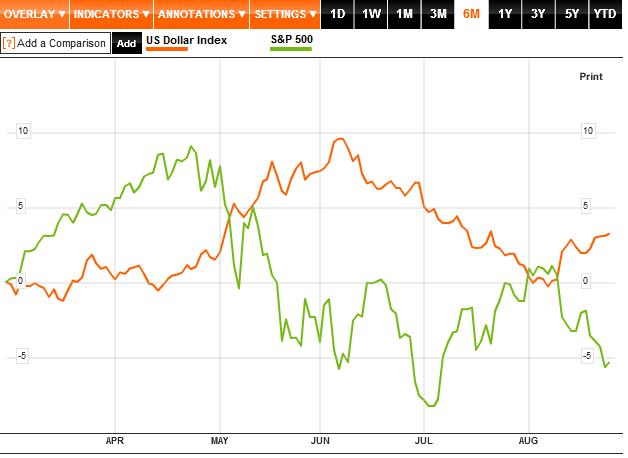
Statisticians love to teach the dictum, Correlation does not imply causation. Nonetheless, I think that in this case, I’d wager to say that the equity and credit/bond markets are driving forex, rather than the other way around. Consider as evidence that, “[Retail] Investors withdrew a staggering $33.12 billion from domestic stock market mutual funds in the first seven months of this year,” and shifted this capital into bonds. While this wouldn’t in itself be enough to drive the Dollar higher, it epitomizes the steady shifts that have been taking place in capital markets for nearly a year, broken only by the S&P/Euro rally in the spring (which now appears to have been an aberration).
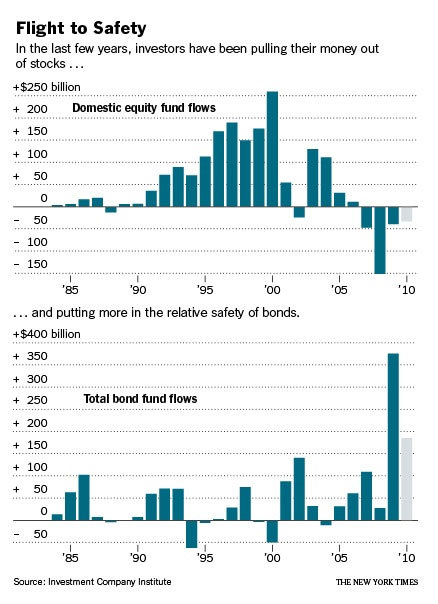
In fact, these shifts are once again creating shortages of Dollars: “This week, two banks bid at the European Central Bank’s weekly dollar liquidity providing auction – the first time there have been any bids since May – suggesting that they could not raise dollars in the market.” This suggests that demand for the Dollar could continue to grow.
Some analysts have suggested that the low-yielding US Dollar is already on its way to becoming a funding currency for carry traders, but I think this is wishful thinking. The HSBC report supports this conclusion, “A weakening of the ‘risk on-risk off’ paradigm is likely only once macro conditions are improved in a sustainable way…Currency performance will likely be tied to the ebb and flow of the perception of risk for some months to come.” In short, until there is solid proof that the global economy has emerged from recession (even if ironically it is the US which is leading the pack downward), the Dollar will probably remain strong.
Trading In Emerging/Exotic Currencies Increases
The long wait is over! The Bank of International Settlements (BIS) has just released the results from its Triennial Central Bank Survey of Foreign Exchange and Derivatives Market Activity, conducted in April 2010. The report contains a veritable treasure trove of data, perhaps enough to keep analysts busy until the next report is released in 2013. [Chart below courtesy of WSJ].
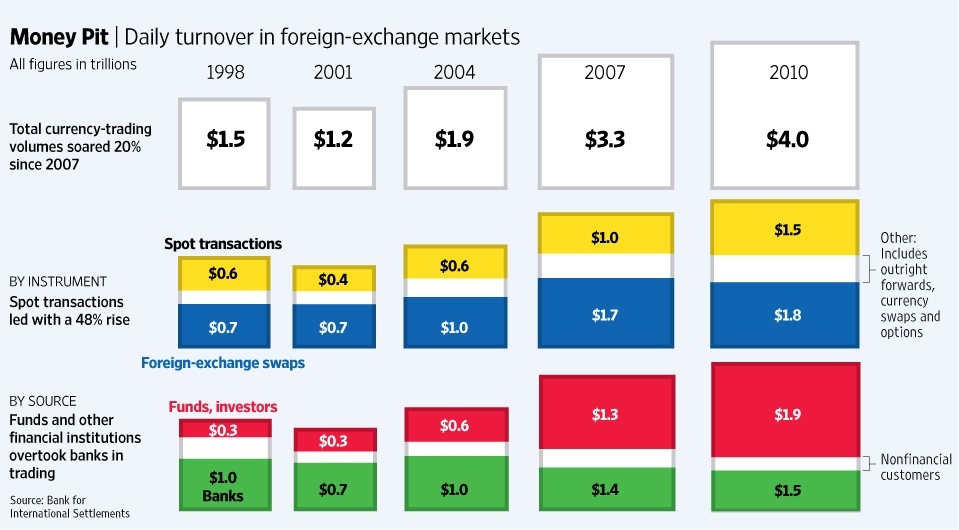
First, the data confirmed earlier reports that average daily forex volume had surged to a record level in 2010: “Global foreign exchange market turnover was 20% higher in April 2010 than in April 2007, with average daily turnover of $4.0 trillion compared to $3.3 trillion. The increase was driven by the 48% growth in turnover of spot transactions, which represent 37% of foreign exchange market turnover. The increase in turnover of other foreign exchange instruments [consisting mainly of swaps and accounting for the majority of forex trading activity] was more modest at 7%.” In addition, for the first time, investors and financial institutions accounted for a larger share of turnover than banks, whose trading activity has remained roughly unchanged since 2004.
The composition of the turnover actually didn’t change from 2007, interrupting a shift which had been taking place over the previous 10 years. Specifically, the share of overall turnover accounted for by the so-called major currencies actually increased in 2010, from 172% to 175%. [Since there are two currencies in every transaction, total volume sums to 200%]. Growth in the G4 currencies (Dollar, Euro, Pound, Yen) was more modest, however, increasing from 154% to 155%. This reversal is probably attributable to the credit crisis, which drove (and in fact, continues to drive) investors out of emerging market currencies and back into safe haven currencies, namely the Dollar, Yen, and Pound. However, this theory is belied by the significant increase in Euro trading activity, which certainly hasn’t benefited from the recent trend towards risk aversion.
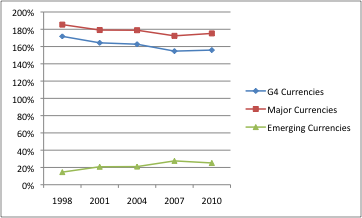
While emerging currencies as a group accounted for a smaller share of overall activity, certain individual currencies managed to increase their respective shares. The Singapore Dollar, Korean Won, New Turkish Lira, and Brazilian Real all fit into this category. Still other currencies, such as the Indonesian Rupiah and Malaysian Ringgit, also managed impressive gains but account for such a small share of volume as to be insignificant when looking at the overall the picture. Those who were expecting even bigger growth should remember that it’s ultimately a numbers game: the amount of Ringgit it outstanding is dwarfed by the number of Dollars, so any gains that the Ringgit can eke out are impressive. In addition, when you consider that the overall forex pie is also increasing, the nominal increase in volume for these small currencies was actually quite large.
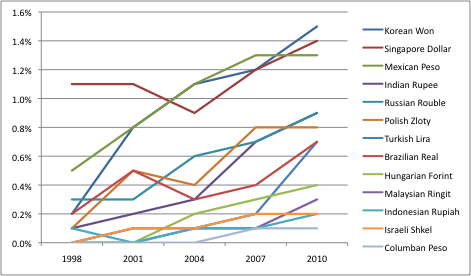
The ongoing search for yield in all corners of the financial markets is likely to bring some of the more obscure currencies into the fold. “In June, I began getting questions about Uruguay, Vietnam and others,” said Win Thin, senior currency strategist at Brown Brothers Harriman in New York…investors often asked Mr. Thin questions about less-familiar currencies such as the Ukrainian hryvnia and Romanian leu.” In the same article, however, Mr. Thin cautioned that interest in such currencies is still probably lower than in 2007-2008, for a good reason. “It’s not like the Group of 10, or even the more liquid emerging market currencies where, if you decide you’ve made a mistake, you can get out.”
Due to the lack of liquidity and higher spreads, these obscure currencies aren’t really suitable for trading. Of course there will be a handful of institutional and even retail investors that want to make long-term bets on these currencies. They tend to be more aware of the risk and less sensitive to the higher cost and lower convenience. The overwhelming majority of traders, however, churn their portfolios daily, if not hundreds of times per day. A 10pip spread on the USD/MXN (Dollar/Mexican Peso) would be considered too high, let alone a 50 pip spread on any transaction involving the Ukrainian hryvnia.
In short, the majors will account for the majority of trading volume for the foreseeable future, regardless of what happens to the Euro. At the same time, that won’t prevent a handful of selected emerging currencies, such as the Chinese Yuan, Indian Rupee, Brazilian Real, and Russian Ruble from increasing their share. As liquidity rises and spreads decline, volume will increase, and their rising importance will become self-fulfilling.
Trend is your friend
Raise your hand if you’ve ever heard that expression before? Well, now there’s proof that this well-worn phrase is more than just a pointless platitude: “Royal Bank of Scotland Group indexes that track the performance of four of the most popular currency strategies show that the so-called trend style was the best-performing method, returning 7.3 percent this year through August.”
“Trend-Style” trading is also known as trend-following, and is just as it sounds. Traders identify one-way patterns in specific currency pair(s), and attempt to ride them for as long as possible. Given all of the big movements in currency markets this year, it’s no wonder that trend-following is the most popular. If you look at the 52 week trading ranges for the six most popular USD currency pairs, you can see that highs and lows are often as far as 20% apart. The EUR/USD pair, for example, fell 20% over a mere 7 months. Anyone who sold in December 2009 and bought to cover in June 2010 would have earned an annualized return of 35% without leverage! Even if you had captured only a couple months of depreciation would have yielded impressive returns. In addition, you could have traded the Euro back up from June until August and reaped a 60% annualized return. Best of all, both of these trends (down, then up) unfolded very smoothly, with only minor corrections along the way.
 I’m sure serious technical analysts are rolling their eyes at the chart above, but the point stands that trend-following has never been easier and rarely more profitable than it is now. One fund manager summarized, “Trend-following investors are capturing the momentum in several big currency moves. You have so much uncertainty in the world now with regard to inflation or deflation, which typically makes currency markets and interest rates move. That is good for trend followers as it causes volatility, which typically creates good profits.” In other words, there is a tremendous amount happening in forex markets at the moment, and this is reflected in protracted, deep moves in currency pairs, which can change direction without notice and yet continue moving the opposite way for just as long. If you think this sounds obvious, look at historical data (5-10 years) for the majority of currency pairs: while trends have always been abundant, it was only recently that they began to last longer and became more pronounced.
I’m sure serious technical analysts are rolling their eyes at the chart above, but the point stands that trend-following has never been easier and rarely more profitable than it is now. One fund manager summarized, “Trend-following investors are capturing the momentum in several big currency moves. You have so much uncertainty in the world now with regard to inflation or deflation, which typically makes currency markets and interest rates move. That is good for trend followers as it causes volatility, which typically creates good profits.” In other words, there is a tremendous amount happening in forex markets at the moment, and this is reflected in protracted, deep moves in currency pairs, which can change direction without notice and yet continue moving the opposite way for just as long. If you think this sounds obvious, look at historical data (5-10 years) for the majority of currency pairs: while trends have always been abundant, it was only recently that they began to last longer and became more pronounced.The other three strategies surveyed by the Royal Scotland Group (“RSG”) were the Carry Trade, Value Trade, and Volatility Trade. Unfortunately, data was only offered for the carry trade strategy (confusingly referred to by RSG as the volatility strategy), which is down 5.9% in the year-to-date. The carry trade strategy involves selling a currency with a low yield and favor of one with a high yield, and profiting from the interest rate spread. In order for this strategy to be profitable, however, the long currency must either appreciate or remain constant. Thus, when volatility is high – as it has been over the last 2-3 years – this is a losing strategy.
We can only guess that a true volatility strategy probably would have been the second most profitable strategy. This strategy can be implemented through the use of long and short spot positions, as well as through trading in options and other derivatives. As I said, there is no shortage of volatility at the moment: “Since the collapse of Lehman Brothers in 2008, the dollar has seen record volatility against the euro…including six moves of at least 10%.” For traders that profit from volatility, the current uncertainty has created a windfall situation.
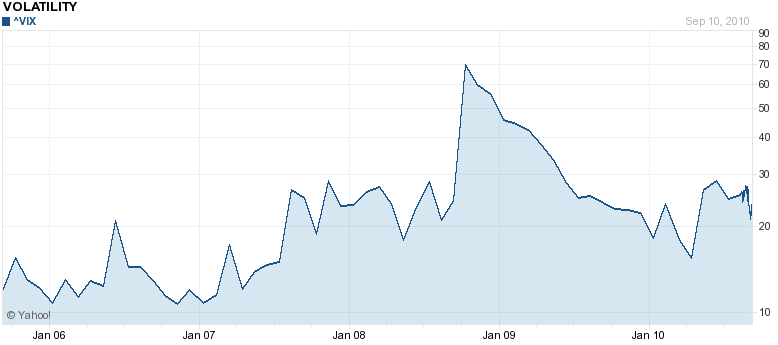
However, it has made value trading – based on fundamentals and the notion of Purchasing Power Parity (PPP) – risky and unpopular: “The volatility also has made what would appear to be a straightforward bet against the dollar fraught with risk. Three factors tend to move currencies: the pace of growth, debt levels and interest rates. By those standards, the dollar should be falling against the currencies of emerging-market and commodity-producing nations.” Not only is this not the case (a decline in risk appetite has turned the Dollar into a safe-haven), but even betting on a protracted Dollar decline is itself risky because of surging volatility. One way around this is to trade a Dollar Index (by way of an ETF, for example) which is inherently less volatile (half as volatile, to be exact) than individual currency pairs.
That’s not to say that value trading isn’t profitable over the long-term. “Empirical evidence suggests that currencies…show a tendency to revert back toward PPP in the longer run.” Given current volatility/uncertainty, however, this strategy is unlikely to be profitable in the short run. Fortunately, uncertainty doesn’t negate opportunity, and traders should plot strategy accordingly.
CFTC / NFA Enhance Regulation of Forex
In 2010, the US Commodity Future Trading Commission (CFTC) formally released a series of new regulations governing all retail foreign exchange dealers. Having given all applicable firms almost six months to bring their operations up to speed with the new regulations, the CFTC is now moving to bring enforcement actions against those that are still not in compliance.
Among other things, the regulations required all retail forex broker-dealers to register accordingly with the National Futures Association (NFA), and for firms that “solicit orders, exercise discretionary trading authority or operate pools with respect to retail forex” to register as introducing brokers. Out of curiosity, I scoured the NFA Background Affiliation Status Information Center (BASIC) to see if/how forex brokers have registered themselves.
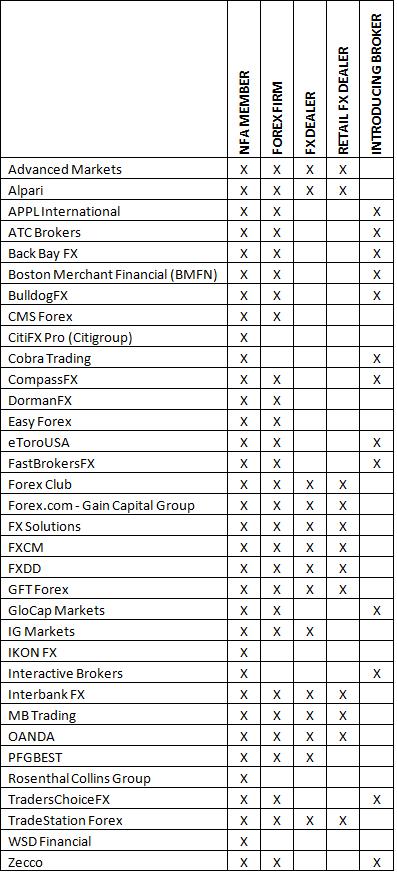
As you can see from the table above, there are approximately [I would be grateful if you could inform me of any known omissions!] 28 registered forex firms, and the CFTC recommends that (US) retail forex traders that manage their own accounts should deal with these firms exclusively.
Unfortunately, many firms continue to advertise that themselves as forex brokers when they aren’t registered as such, or even worse, aren’t registered at all. As a result, the CFTC recently filed simultaneous enforcement actions against 14 forex firms, alleging that, “In all but two of the complaints…a defendant acted as an RFED; that is, it offered to take or took the opposite side of a customer’s forex transaction without being registered. In the remaining two complaints, ZtradeFX LLC and FXPRICE, the CFTC alleges that the defendant solicited customers to place forex trades at an RFED without being registered as an Introducing Broker.” The following companies stand accused:

To be a fair, NFA membership doesn’t necessarily imply compliance with NFA regulations, nor does it even guarantee upright behavior. In fact, the NFA is currently scrutinizing all of its member firms “for any signs they are designing computer systems to take advantage of what is known in the industry as ‘slippage,’ or small price movements that happen between the time a customer orders a trade and when that trade is actually executed.” In October, the NFA settled two such cases with IKON FX and Gain Capital, assessing a combined $800,000 in fines. Let’s hope that this isn’t the real explanation for the fact that forex trading is vastly more profitable for brokerages than other types of retail securities trading.
While the NFA hasn’t indicated that this is the case, the current retail forex MO (whereby brokers also act as market-makers) could be under attack. As one advocate for traders told the WSJ, “If a foreign-exchange firm is acting as a market-maker, or taking the other side of a client’s trades, it is doubtful the investor is getting the best possible price.” The problem is at the moment, the industry remains far from transparent, and if not for the NFA investigations, traders probably wouldn’t be able to establish whether their broker(s) acted unscrupulously.
Among other things, the regulations required all retail forex broker-dealers to register accordingly with the National Futures Association (NFA), and for firms that “solicit orders, exercise discretionary trading authority or operate pools with respect to retail forex” to register as introducing brokers. Out of curiosity, I scoured the NFA Background Affiliation Status Information Center (BASIC) to see if/how forex brokers have registered themselves.

As you can see from the table above, there are approximately [I would be grateful if you could inform me of any known omissions!] 28 registered forex firms, and the CFTC recommends that (US) retail forex traders that manage their own accounts should deal with these firms exclusively.
Unfortunately, many firms continue to advertise that themselves as forex brokers when they aren’t registered as such, or even worse, aren’t registered at all. As a result, the CFTC recently filed simultaneous enforcement actions against 14 forex firms, alleging that, “In all but two of the complaints…a defendant acted as an RFED; that is, it offered to take or took the opposite side of a customer’s forex transaction without being registered. In the remaining two complaints, ZtradeFX LLC and FXPRICE, the CFTC alleges that the defendant solicited customers to place forex trades at an RFED without being registered as an Introducing Broker.” The following companies stand accused:

To be a fair, NFA membership doesn’t necessarily imply compliance with NFA regulations, nor does it even guarantee upright behavior. In fact, the NFA is currently scrutinizing all of its member firms “for any signs they are designing computer systems to take advantage of what is known in the industry as ‘slippage,’ or small price movements that happen between the time a customer orders a trade and when that trade is actually executed.” In October, the NFA settled two such cases with IKON FX and Gain Capital, assessing a combined $800,000 in fines. Let’s hope that this isn’t the real explanation for the fact that forex trading is vastly more profitable for brokerages than other types of retail securities trading.
While the NFA hasn’t indicated that this is the case, the current retail forex MO (whereby brokers also act as market-makers) could be under attack. As one advocate for traders told the WSJ, “If a foreign-exchange firm is acting as a market-maker, or taking the other side of a client’s trades, it is doubtful the investor is getting the best possible price.” The problem is at the moment, the industry remains far from transparent, and if not for the NFA investigations, traders probably wouldn’t be able to establish whether their broker(s) acted unscrupulously.
Hedging High Forex Uncertainty
In forex, everything is relative. That is no less the case for forex volatility, which is low relative to the spikes in 2008 (credit crisis) and 2010 (EU Sovereign debt crisis), but high relative to the preceding 5+ years of stability. On the one hand, volatility is approaching a two year low. On the other hand, analysts continue to warn of high volatility for the foreseeable future. Under these conditions, what are (currency) investors supposed to do?!
Despite the steady pickup in risk appetite in 2010, there remains a whole a host of forex risk factors. On the economic front, GDP growth remains anemic in western countries, unemployment is high, and consumer confidence is low. Budget deficits and national debts are rising, perhaps to the point that default by a major industrialized countries is inevitable. Emerging market countries seem to be ‘suffering’ from the opposite problem, whereby rapid growth, high commodities prices, and capital inflow has caused inflation to rise precipitously. Some Central Banks will be forced to hike interest rates, while others will try to maintain an easy monetary policy for as long as possible. Political crises flare-up without warning, the Euro risks breaking up, and inclement weather is wreaking havoc on food production.
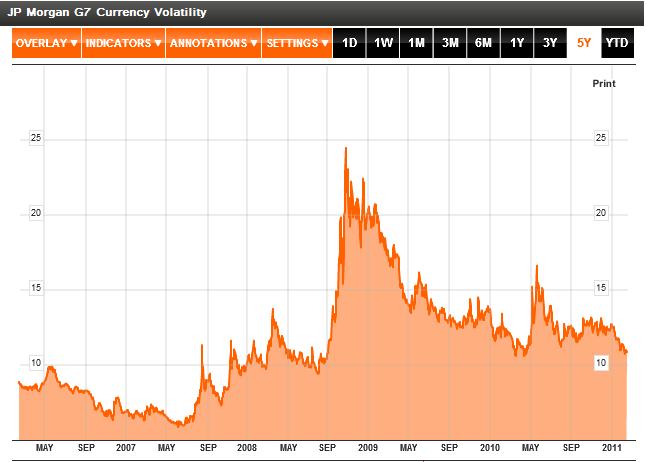 As a result, most currency-market watchers expect 2011 to be a continuation of 2010. In other words, while we might be spared a major crisis, a generalized sense of uncertainty will continue to pervade forex. According to JP Morgan, “Implied volatility on options for major exchange rates averaged 12.34 percent this year, compared with an average of 10.6 percent since January 2000.” The currency team of UBS predicts, “The divergence between the strength in emerging markets and the unusual levels of uncertainty in the world’s major economies will cause…super volatility,” whereby massive swings in exchange rates will become the norm.
As a result, most currency-market watchers expect 2011 to be a continuation of 2010. In other words, while we might be spared a major crisis, a generalized sense of uncertainty will continue to pervade forex. According to JP Morgan, “Implied volatility on options for major exchange rates averaged 12.34 percent this year, compared with an average of 10.6 percent since January 2000.” The currency team of UBS predicts, “The divergence between the strength in emerging markets and the unusual levels of uncertainty in the world’s major economies will cause…super volatility,” whereby massive swings in exchange rates will become the norm.
In this environment, there are a number of things that currency traders should do. The first step is simply to be aware that volatility remains high, which means that wider-than-average fluctuations shouldn’t be a surprise. The next step is to decide whether you think that this volatility will remain at an elevated level for the near-term, or whether you expect it to continue declining. (It’s worth pointing out that volatility is not necessarily a perception of absolute risk, but investor perception of risk). The final step is deciding if/how you will tailor your trading strategy in response to changes in volatility.
In fact, you don’t necessarily need to limit your exposure to volatility. If you are a fundamental investor with a long-term approach, you may very well choose to write-off short-term fluctuations as noise. (Of course, if you are a short-term swing trader, you can’t afford to be quite so indifferent). In addition, if your primary interest is in another asset type, you may choose not to hedge any currency risk. Perhaps you believe that the base currency will continue appreciated and/or you relish the exposure to currency movements as an added benefit of asset price exposure. Along these lines, “During the planning stages of the UBS Emerging Markets Equity Income fund, UBS Global Asset Management considered offering investors a hedged share class. The team abandoned the idea when investors showed a preference for unhedged share classes.”
In addition, hedging currency risk is expensive, especially for exotic/illiquid currencies, and currencies characterized by above average volatility. Not to mention that currency hedges can still move against investors, resulting in heavy losses. Still, in 2010, “Corporations from the U.S., Japan and Europe increased the percentage of projected income protected against swings in exchange rates to a record,” which suggests that fear of adverse exchange rate movements still predominates.
Finally, there are those that want to construct second-order currency strategies based entirely on volatility. Using basic options techniques, such as spreads and straddles, it’s possible to profit from volatility (or lack thereof) regardless of which direction the underlying currencies move in. In fact, the CME Group recently introduced a new product series which seeks to perform this very function. Investors can already buy and sell futures based on short-term volatility in the EUR/USD, which will soon be replicated for all of the major currency pairs.
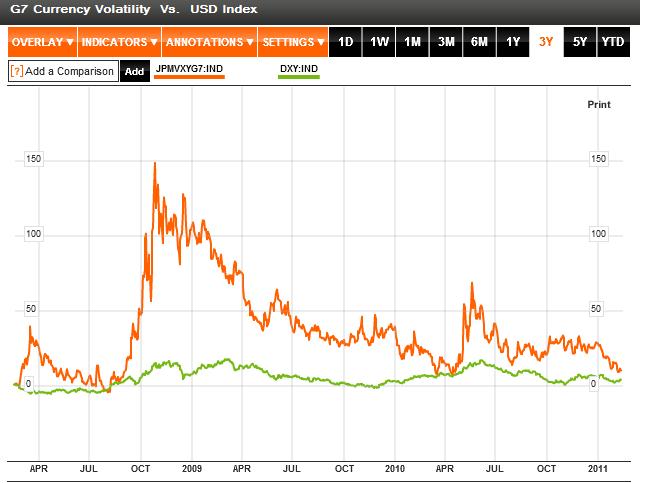
For those of you who like to keep it simple, it’s probably enough to monitor the JP Morgan G7 Currency Volatility Index, which is a good proxy for the risk associated with trading (major) currencies at any given time. When this index spikes, chances are the US Dollar and other safe haven currencies will follow suit.
Despite the steady pickup in risk appetite in 2010, there remains a whole a host of forex risk factors. On the economic front, GDP growth remains anemic in western countries, unemployment is high, and consumer confidence is low. Budget deficits and national debts are rising, perhaps to the point that default by a major industrialized countries is inevitable. Emerging market countries seem to be ‘suffering’ from the opposite problem, whereby rapid growth, high commodities prices, and capital inflow has caused inflation to rise precipitously. Some Central Banks will be forced to hike interest rates, while others will try to maintain an easy monetary policy for as long as possible. Political crises flare-up without warning, the Euro risks breaking up, and inclement weather is wreaking havoc on food production.

In this environment, there are a number of things that currency traders should do. The first step is simply to be aware that volatility remains high, which means that wider-than-average fluctuations shouldn’t be a surprise. The next step is to decide whether you think that this volatility will remain at an elevated level for the near-term, or whether you expect it to continue declining. (It’s worth pointing out that volatility is not necessarily a perception of absolute risk, but investor perception of risk). The final step is deciding if/how you will tailor your trading strategy in response to changes in volatility.
In fact, you don’t necessarily need to limit your exposure to volatility. If you are a fundamental investor with a long-term approach, you may very well choose to write-off short-term fluctuations as noise. (Of course, if you are a short-term swing trader, you can’t afford to be quite so indifferent). In addition, if your primary interest is in another asset type, you may choose not to hedge any currency risk. Perhaps you believe that the base currency will continue appreciated and/or you relish the exposure to currency movements as an added benefit of asset price exposure. Along these lines, “During the planning stages of the UBS Emerging Markets Equity Income fund, UBS Global Asset Management considered offering investors a hedged share class. The team abandoned the idea when investors showed a preference for unhedged share classes.”
In addition, hedging currency risk is expensive, especially for exotic/illiquid currencies, and currencies characterized by above average volatility. Not to mention that currency hedges can still move against investors, resulting in heavy losses. Still, in 2010, “Corporations from the U.S., Japan and Europe increased the percentage of projected income protected against swings in exchange rates to a record,” which suggests that fear of adverse exchange rate movements still predominates.
Finally, there are those that want to construct second-order currency strategies based entirely on volatility. Using basic options techniques, such as spreads and straddles, it’s possible to profit from volatility (or lack thereof) regardless of which direction the underlying currencies move in. In fact, the CME Group recently introduced a new product series which seeks to perform this very function. Investors can already buy and sell futures based on short-term volatility in the EUR/USD, which will soon be replicated for all of the major currency pairs.

For those of you who like to keep it simple, it’s probably enough to monitor the JP Morgan G7 Currency Volatility Index, which is a good proxy for the risk associated with trading (major) currencies at any given time. When this index spikes, chances are the US Dollar and other safe haven currencies will follow suit.
Forex Volatility Rises from Multi-Year Lows
In the last month, volatility in the forex markets touched both a two-year low and a one-year high. In the beginning of March, volatility essentially returned to pre-credit crisis levels. One week later, when the earthquake and inception of the nuclear crisis in Japan, volatility surged 40%. While it has since resumed its downward path, investors are still bracing themselves for continued uncertainty.
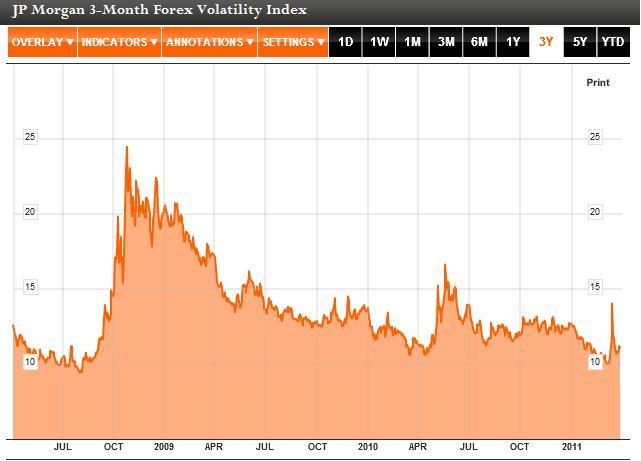
The carry trade has perhaps born the brunt of the volatility spike. The carry trade depends on interest rate differentials – as opposed to currency appreciation – to drive profits, and thus demands stability. When the markets become choppy and exchange rates spike wildly in one direction or another, it makes the carry trade significantly more risky. Hence the paradoxical rise of the Japanese Yen to a record high following a series of crushing disasters, as highly leveraged traders moved to unwind their Yen-short carry trades.Likewise, high volatility should spur demand for so-called safe haven currencies. If only it were clear what constitutes a safe haven currency. Traditionally, that would send the US Dollar, Swiss Franc, and Japanese Yen upwards. In this case, the Franc has benefited most, followed closely by the Yen. The Dollar spiked against emerging market and high-risk currencies, but hardly budged against its G4 counterparts. Could it be that the Dollar’s multi-year positive correlation with volatility has (temporarily?) abated.
With regard to strategy, currency traders have a handful of choices. If you believe that volatility will continue declining or remain stable, you’re probably going to go long emerging market and high-yielding currencies, and short one of the safe-haven currencies, all of which are quite cheap to borrow. The main risk of such a strategy, of course, is that volatility will once again spike, in which these safe have currencies will rally.
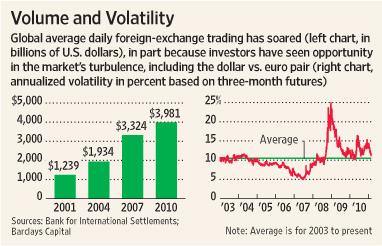
If you think that the ebb and volatility isn’t sustainable, then you’re probably going to bet on the Franc, Dollar, or Yen. As I wrote in an earlier post, I think the Yen could theoretically appreciate in the short-term, but actually remains quite risky over the long-term. Despite the best efforts of the Swiss National Bank, the Franc will probably continue appreciation. Economically and monetarily, it is in an excellent shape. Besides, the fact that the supply of Francs is intrinsically small means that even modest capital inflow often translates into a big jump in its its value. As for the Dollar, it is now the most popular currency to short. It remains a safe choice and a good store of value, but probably won’t deliver the returns that safe-haven strategists have come to expect.
From a practical standpoint, you may also want to consider reducing your leverage. As everyone knows, high leverage increases profits but also magnifies losses. In the current environment of heightened volatility, leverage also magnifies risk. Either way, you may also want to consider hedging your exposure, by trading a basket of currencies and/or through the use of options.

The carry trade has perhaps born the brunt of the volatility spike. The carry trade depends on interest rate differentials – as opposed to currency appreciation – to drive profits, and thus demands stability. When the markets become choppy and exchange rates spike wildly in one direction or another, it makes the carry trade significantly more risky. Hence the paradoxical rise of the Japanese Yen to a record high following a series of crushing disasters, as highly leveraged traders moved to unwind their Yen-short carry trades.
With regard to strategy, currency traders have a handful of choices. If you believe that volatility will continue declining or remain stable, you’re probably going to go long emerging market and high-yielding currencies, and short one of the safe-haven currencies, all of which are quite cheap to borrow. The main risk of such a strategy, of course, is that volatility will once again spike, in which these safe have currencies will rally.

If you think that the ebb and volatility isn’t sustainable, then you’re probably going to bet on the Franc, Dollar, or Yen. As I wrote in an earlier post, I think the Yen could theoretically appreciate in the short-term, but actually remains quite risky over the long-term. Despite the best efforts of the Swiss National Bank, the Franc will probably continue appreciation. Economically and monetarily, it is in an excellent shape. Besides, the fact that the supply of Francs is intrinsically small means that even modest capital inflow often translates into a big jump in its its value. As for the Dollar, it is now the most popular currency to short. It remains a safe choice and a good store of value, but probably won’t deliver the returns that safe-haven strategists have come to expect.
From a practical standpoint, you may also want to consider reducing your leverage. As everyone knows, high leverage increases profits but also magnifies losses. In the current environment of heightened volatility, leverage also magnifies risk. Either way, you may also want to consider hedging your exposure, by trading a basket of currencies and/or through the use of options.
Retail Forex: Lower Corporate Profits = Lower Spreads for Traders?
In December 2010, both GAIN Capital and FXCM became public companies. This was thought both to signal the maturing of an industry and to herald the start of a period of explosive growth. Since then, the share prices for both companies have fallen dramatically, even while the S&P 500 has continued to rise. Trading volume has remained flat, and revenues have declined. As a result, analysts (myself included) are starting to question not only the operations of these two firms, but also of the entire industry.
Before we jump to conclusions, it’s important to understand the basis for this sudden aura of uncertainty . First of all, both firms – as well as the broader forex industry – have found themselves the subject of increased regulatory scrutiny, and consequent disciplinary action. Second, trading volume has been impacted by an uptick in volatility. Third, an increase in institutional trading volume has not translated into a proportional increase in revenues/profits. Fourth, the recent tightening of leverage rules (which may be helping traders!) has eroded a large profit center. Finally, high account turnover suggests that the brokers will eventually run out of customers.
I don’t want to dwell on the industry’s regulatory travails (since I have blogged about it before), except to say that I think it’s a good thing. It will bring greater transparency, and generally make trading safer and cheaper. For more information on the specific allegations and (potential) regulatory response, the WSJ recently published an excellent overview.

As for the temporary decline in retail trading volume, this is probably temporary. Overall forex volume has tripled over the last decade, and it is forecast to triple again over the coming decade. In addition, the mainstreaming of currency trading will spur millions of investors to at least dabble on forex. Unfortunately, this will probably be offset by a decline in trading activity by existing customers, as the majority come to terms with the difficulty of profiting through high-volume/high-leverage trading.
Furthermore, increased volume will combine with increased competition to facilitate lower spreads. According to a recent report by LeapRate, GAIN Capital now earns an average of only 1.7 pips per trade, a stunning drop for the 2.7 pips that it averaged during most of 2010. Basically, the same thing is now happening to forex that decimalization and computerization brought to bear on stocks. If hedge funds and other institutional traders continue to enter the market en masse, spreads will be arbitraged away to the point that 1-2 pips (or even smaller!) should become the norm for all major currency pairs.
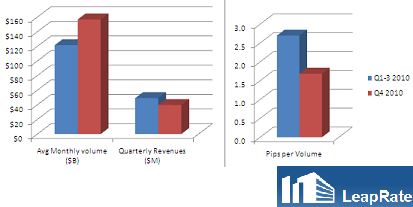
In short, retail forex traders should applaud the decline in stock prices. After all, what’s good for traders is probably going to be bad for business. Liquidity is increasing, and spreads are falling. Enhanced regulation is eliminating shadowy sources of profit and will make trading more secure. The only thing left to hope for is that all forex brokers go public, and open up their books to the same level of scrutiny as GAIN Capital and FXCM.
Before we jump to conclusions, it’s important to understand the basis for this sudden aura of uncertainty . First of all, both firms – as well as the broader forex industry – have found themselves the subject of increased regulatory scrutiny, and consequent disciplinary action. Second, trading volume has been impacted by an uptick in volatility. Third, an increase in institutional trading volume has not translated into a proportional increase in revenues/profits. Fourth, the recent tightening of leverage rules (which may be helping traders!) has eroded a large profit center. Finally, high account turnover suggests that the brokers will eventually run out of customers.
I don’t want to dwell on the industry’s regulatory travails (since I have blogged about it before), except to say that I think it’s a good thing. It will bring greater transparency, and generally make trading safer and cheaper. For more information on the specific allegations and (potential) regulatory response, the WSJ recently published an excellent overview.

As for the temporary decline in retail trading volume, this is probably temporary. Overall forex volume has tripled over the last decade, and it is forecast to triple again over the coming decade. In addition, the mainstreaming of currency trading will spur millions of investors to at least dabble on forex. Unfortunately, this will probably be offset by a decline in trading activity by existing customers, as the majority come to terms with the difficulty of profiting through high-volume/high-leverage trading.
Furthermore, increased volume will combine with increased competition to facilitate lower spreads. According to a recent report by LeapRate, GAIN Capital now earns an average of only 1.7 pips per trade, a stunning drop for the 2.7 pips that it averaged during most of 2010. Basically, the same thing is now happening to forex that decimalization and computerization brought to bear on stocks. If hedge funds and other institutional traders continue to enter the market en masse, spreads will be arbitraged away to the point that 1-2 pips (or even smaller!) should become the norm for all major currency pairs.

In short, retail forex traders should applaud the decline in stock prices. After all, what’s good for traders is probably going to be bad for business. Liquidity is increasing, and spreads are falling. Enhanced regulation is eliminating shadowy sources of profit and will make trading more secure. The only thing left to hope for is that all forex brokers go public, and open up their books to the same level of scrutiny as GAIN Capital and FXCM.
Icelandic Kronur: Lessons from a Failed Carry Trade
A little more than two years ago, the Icelandic Kronur was one of the hottest currencies in the world. Thanks to a benchmark interest rate of 18%, the Kronur had particular appeal for carry traders, who worried not about the inherent risks of such a strategy. Shortly thereafter, the Kronur (as well as Iceland’s economy and banking sector) came crashing down, and many traders were wiped out. Now that a couple of years have passed, it’s probably worth reflecting on this turn of events.
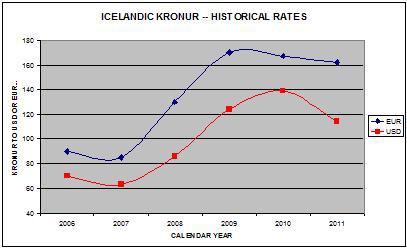
At its peak, nominal GDP was a relatively modest $20 Billion, sandwiched between Nepal and Turkmenistan in the global GDP rankings. Its population is only 300,000, its current account has been mired in persistent deficit, and its Central Bank boasts a mere $8 Billion in foreign exchange reserves. That being the case, why did investors flock to Iceland and not Turkmenistan?
The short answer to that question is interest rates. As I said, Iceland’s benchmark interest rate exceeded 18% at its peak. There are plenty of countries that offered similarly high interest rates, but Iceland was somehow perceived as being more stable. While it didn’t apply to join the European Union (its application is still pending) until last year, Iceland has always benefited from its association with Europe in general, and Scandinavia in particular. Thanks to per capita GDP of $38,000 per person, its reputation as a stable, advanced economy was not unwarranted.
On the other hand, Iceland has always struggled with high inflation, which means its interest rates were never very high in real terms. In addition, the deregulation of its financial sector opened the door for its banks to take huge risks with deposits. Basically, depositors – many from outside the country – parked their savings in Icelandic banks, which turned around and invested the money in high-yield / high-risk ventures. When the credit crisis struck, its banks were quickly wiped out, and the government chose not to follow in the footsteps of other governments and bail them out.
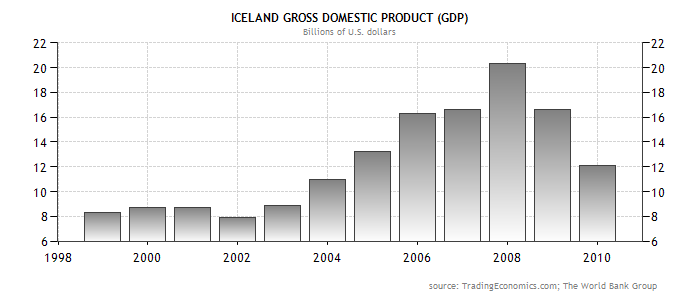
Moreover, it doesn’t look like Iceland will regain its luster any time soon. Its economy has shrunk by 40% over the last two years, and one prominent economist has estimated that it will take 7-10 years for it to fully recover. Unemployment and inflation remain high even though interest rates have been cut to 4.25% – a record low. The Kronur has lost 50% of its value against the Dollar and the Euro, the stock market has been decimated, and the recent decision to not remunerate Dutch and British insurance companies that lost money in Iceland’s crash will only serve to further spook foreign investors. In short, while the Kronur will probably recover some of its value over the next few years (aided by the possibility of joining the Euro), it probably won’t find itself on the radar screens of carry traders anytime soon.In hindsight, Iceland’s economy was an accident waiting to happen, and the global financial crisis only magnified the problem. With Iceland – as well as a dozen other currencies and securities – investors believed they had found the proverbial free lunch. After all, where else could you earn an 18% by putting money in a savings account? Never mind that inflation was just as high; with the Kronur rising, carry traders felt assured that they would make a tidy profit on any funds deposited in Iceland.

At its peak, nominal GDP was a relatively modest $20 Billion, sandwiched between Nepal and Turkmenistan in the global GDP rankings. Its population is only 300,000, its current account has been mired in persistent deficit, and its Central Bank boasts a mere $8 Billion in foreign exchange reserves. That being the case, why did investors flock to Iceland and not Turkmenistan?
The short answer to that question is interest rates. As I said, Iceland’s benchmark interest rate exceeded 18% at its peak. There are plenty of countries that offered similarly high interest rates, but Iceland was somehow perceived as being more stable. While it didn’t apply to join the European Union (its application is still pending) until last year, Iceland has always benefited from its association with Europe in general, and Scandinavia in particular. Thanks to per capita GDP of $38,000 per person, its reputation as a stable, advanced economy was not unwarranted.
On the other hand, Iceland has always struggled with high inflation, which means its interest rates were never very high in real terms. In addition, the deregulation of its financial sector opened the door for its banks to take huge risks with deposits. Basically, depositors – many from outside the country – parked their savings in Icelandic banks, which turned around and invested the money in high-yield / high-risk ventures. When the credit crisis struck, its banks were quickly wiped out, and the government chose not to follow in the footsteps of other governments and bail them out.

Moreover, it doesn’t look like Iceland will regain its luster any time soon. Its economy has shrunk by 40% over the last two years, and one prominent economist has estimated that it will take 7-10 years for it to fully recover. Unemployment and inflation remain high even though interest rates have been cut to 4.25% – a record low. The Kronur has lost 50% of its value against the Dollar and the Euro, the stock market has been decimated, and the recent decision to not remunerate Dutch and British insurance companies that lost money in Iceland’s crash will only serve to further spook foreign investors. In short, while the Kronur will probably recover some of its value over the next few years (aided by the possibility of joining the Euro), it probably won’t find itself on the radar screens of carry traders anytime soon.
The collapse of the Kronur, however, has shown us that the carry trade is anything but risk-free. In fact, 18% is more than what lenders to Greece and Ireland can expect to earn, which means that it is ultimately a very risky investment. In this case, the 18% that was being paid to depositors were generated by making very risky investments. As the negotiations with the insurance companies have revealed, depositors had nothing protecting them from bank failure, which is ultimately what happened.
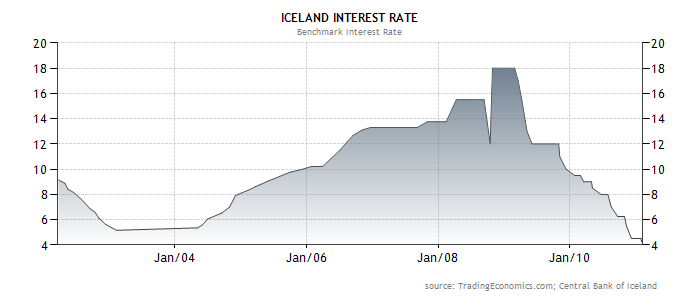 Now that the carry trade is making a comeback, it’s probably a good time to take a step back and re-assess the risks of such a strategy. Even if Iceland proves to be an extreme case – since most countries won’t let their banks fail – traders must still acknowledge the possibility of massive currency depreciation. In other words, even if the deposits themselves are guaranteed, there is an ever-present risk that converting that deposit back into one’s home currency will result in losses. That’s especially true for a currency that is as illiquid as the Kronur (so illiquid that it took me a while to even find a reliable quote!), and is susceptible to liquidity crunches and short squeezes.
Now that the carry trade is making a comeback, it’s probably a good time to take a step back and re-assess the risks of such a strategy. Even if Iceland proves to be an extreme case – since most countries won’t let their banks fail – traders must still acknowledge the possibility of massive currency depreciation. In other words, even if the deposits themselves are guaranteed, there is an ever-present risk that converting that deposit back into one’s home currency will result in losses. That’s especially true for a currency that is as illiquid as the Kronur (so illiquid that it took me a while to even find a reliable quote!), and is susceptible to liquidity crunches and short squeezes.
When you enter into a carry trade, understand that a spike in volatility could wipe out all of your profits in one session. The only way to minimize your risk is to hedge your exposure. Now that the carry trade is making a comeback, it’s probably a good time to take a step back and re-assess the risks of such a strategy. Even if Iceland proves to be an extreme case – since most countries won’t let their banks fail – traders must still acknowledge the possibility of massive currency depreciation. In other words, even if the deposits themselves are guaranteed, there is an ever-present risk that converting that deposit back into one’s home currency will result in losses. That’s especially true for a currency that is as illiquid as the Kronur (so illiquid that it took me a while to even find a reliable quote!), and is susceptible to liquidity crunches and short squeezes.
Now that the carry trade is making a comeback, it’s probably a good time to take a step back and re-assess the risks of such a strategy. Even if Iceland proves to be an extreme case – since most countries won’t let their banks fail – traders must still acknowledge the possibility of massive currency depreciation. In other words, even if the deposits themselves are guaranteed, there is an ever-present risk that converting that deposit back into one’s home currency will result in losses. That’s especially true for a currency that is as illiquid as the Kronur (so illiquid that it took me a while to even find a reliable quote!), and is susceptible to liquidity crunches and short squeezes.Are Forex Markets Underpricing Volatility?
This question has been raised by several market commentators, including The Wall Street Journal. Its recent analysis, entitled “Currency Investors: What, Me Worry?” wondered whether the forex markets might not have become too complacent about risk and have seriously underestimated the possibility of another shock.
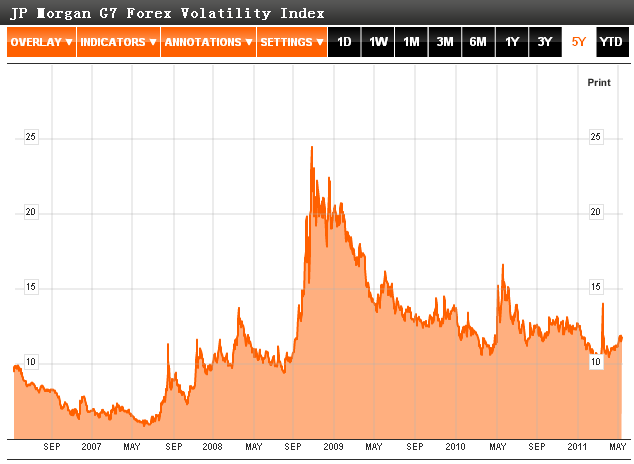
First, some basics. There are two principal volatility measurements: implied
volatility and realized volatility. The former is so-called because it must be deduced indirectly. In the Black-Scholes model for pricing options, volatility is the only unknown variable and thus is implied by current market prices. It serves as a proxy for investor expectations for volatility over the period for which the option is valid. Realized volatility is of course the actual volatility that is observed in currency markets, calculated based on the size of fluctuations over a given period of time. When fluctuations are greater (whether upward or downward), volatility is said to be high.
For short time frames, implied volatility tends to be very close to realized volatility. For longer time-frames, however, this is not necessarily the case: “The long-dated implied volatilities are often driven to extreme values by one-sided demand or supply – the difference between implied and realised volatilities this causes is particularly large during periods of risk aversion in the market…making implied volatility a particularly poor proxy for realised volatility during periods of market unrest.” In practice, this is reflected by higher prices for long-dated put or call options (depending on the direction of the move that investors are trying to hedge against).
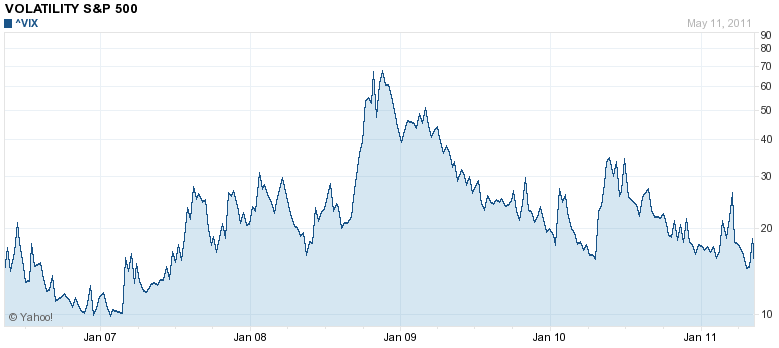
Indeed, most volatility metrics are well below their historical averages and are rapidly closing in on pre-credit crisis levels. This is true for the JP Morgan G7 3-month forex volatility index, the S&P VIX, as well as for specific currencies. Mataf.net (whose content manager I interviewed yesterday) contains replete short-term and long-term data for a few dozen currency pairs, and you can see that almost all of them feature the same downward trend. According to the WSJ, “Investors believe there is a 66% chance each day for the next month that the euro and pound will move no more than 0.6% and 0.5%, respectively—both limited moves.” In addition, “A gauge of the euro’s ‘realized’ volatility, which measures how much daily changes deviate from their recent average, is only 8.6%, lower than its 11% rolling one-year average.”
Of course, some commentators don’t see any problem here. They see it both as a positive indication that the markets have returned to normal following the financial crisis, and as a reflection of the correlation that has developed between stock prices and forex markets. (You can see from the chart below the strong inverse correlation between the S&P and the US dollar). According to Deutsche Bank, “Most news that should have shocked the market this year has not managed to do so for sufficiently long to make volatility rise sustainably. Our analytical models tell us that we are indeed moving to a low volatility environment again.”
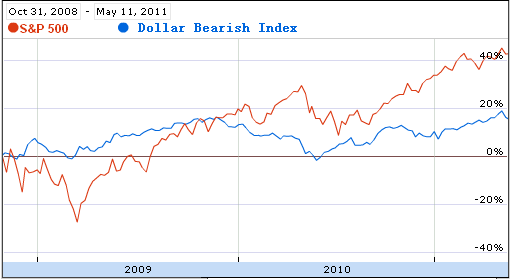
On the other side of the debate is a growing consensus of investors that sees a pendulum that has swung too far. “I just don’t see how volatility will not increase quite substantially,” said one money manager. “There is significant potential for shocks to the system that currency volatility levels suggest the market is not prepared for,” added another, citing higher commodities prices and inflation, growing public debt, and the imminent end of the Fed’s QE2 monetary stimulus.
To be sure, volatility has started to tick up over the last month. This trend has also been reflected in options prices: “Many investors have avoided buying short-dated currency options this year, instead focusing on longer-dated protection, a phenomenon called a ‘steep volatility curve’…that trend has slowed a bit, with investors moving to hedge against near-term yen, euro and dollar swings.”
Currency traders should start to think about making a few adjustments. Those that think that volatility will continue to rise and/or that the markets are currently underpricing risk can employ a volatility strangle strategy, buying way out-of-the-money puts and calls. The options will pay off if there is a big move in either direction, with no downside risk. Those that think that volatility will continue declining or at least remain at current low levels can make use of the carry trade. Those pairs where interest rate differentials are highest and volatility levels are lowest represent the best candidates. BNP Paribas is also reportedly developing a product that will make it easier for traders to make volatility bets without having to rely on indirect means.
High-Frequency Traders Descend onto Forex Markets
According to a recent report by the Wall Street Journal, high-speed traders are quickly establishing themselves as the main force in forex markets. Just like in other financial markets, a significant portion of trading volume is dominated by computerized trading, in which huge blocks of currency can change hands multiple times in mere milliseconds. While this is certainly old news for hedge funds and other institutional traders, it may come as a slight surprise to retail traders, many of whom still see forex as the neglected stepsister of stocks, bonds, and other assets. Nonetheless, there are a number of implications for the forex markets, and retail traders would be wise to heed them.
Here are the facts: “High-frequency trading accounted for roughly 30% of all foreign-exchange flows, as of 2010, compared with 13% in 2004, according to Boston-based consulting firm Aite Group. (By contrast, 66% of global stocks trading is high frequency.” According to Aite Group, it will jump to 42% by the end 2011 and to 60% in 2012. “About 85% of the currency market’s growth in volume from 2007 to 2010 came from financial institutions like hedge funds [represented as other financial institutions in the chart below] rather than Wall Street’s traditional bank currency dealers, thanks partly to high-frequency traders.”

According to the Wall Street Journal, this is changing the way in which currencies are traded. Previously, for big blocks of currency, traders would have to manually request a quote from Wall Street brokerages, which still dominate forex trading through the interbank market. The brokerage would match up buyer and seller (or step in and fulfill one of the roles itself) and take a cut, in the form of the spread. Retail traders, on the other hand, have never known such a troublesome process, having always been afforded electronic quotes and instant execution. However, the price paid for this convenience comes in the form of wide spreads, since both your retail broker and its representative on the interbank markets must both earn a profit.
In fact, wide spreads recently came under attack by Karl Deninger and sparked a fierce debate about whether it is still possible for retail traders to turn a profit using high-frequency (albeit non-computerized) trading methods. Fortunately, the Wall Street Journal is reporting that spreads have already fallen to one pip (though it didn’t specify the currency pair) thanks to new systems that have been set up to cater to high-frequency traders. It seems only a matter of time before these systems are either adapted to the retail market and/or replace the interbank market as the market-maker for retail brokerages. (Given that a handful of banks are currently under investigation by the SEC for deceptive quoting practices, a changing of the guard probably isn’t such a bad thing!)
In addition, while high-frequency trading has increased liquidity and lowered spreads, it has probably increased volatility. Sudden spikes quickly becomes exacerbated as automatic stop orders flood the market. You can see from the chart below the abundance of such spikes, the most recent one on March 11 caused by the Japanese natural disasters. Overall volatility is also at elevated levels, though it’s impossible to know how much of this is due to an increase in high-frequency trading and how much is simply due to post-financial crisis uncertainty. In any event, retail traders with ultra-short time horizons have no choice but to play the same game, by maintaining active stop-loss orders. Traders should also consider reducing leverage, since sudden spikes can trigger margin calls and wipe out entire accounts. (For the record, of the dozens of interviews I have conducted over the last couple years, I have yet to find one expert that condones the use of leverage greater than 5:1.In my opinion, leverage is still nothing more than a cynical marketing tool), but I digress…)
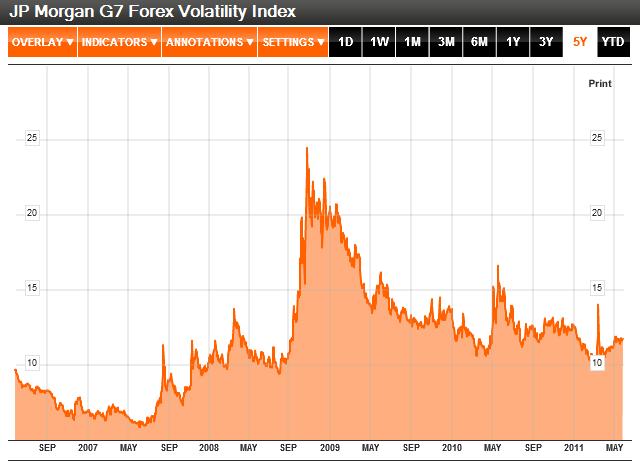
Ultimately, I think this is just further evidence that day-trading forex is only going to become more difficult. According to a research paper (that I spotlighted in an earlier post), algorithmic trading has already caused a decline in the power of technical analysis. Presumably, this is because computerized trading systems are better than humans at identifying trends and faster at executing trades designed to profit from them. In the end, outsmarting computers is unlikely, since both human traders and their electronic counterparts use the same forms of deductive reasons to spot potential trading opportunities. At the same time, the algorithms are still “stupid.” They are designed by humans and can only consider the variables that have been inputted them, which are inherently technical in nature. To beat them, you merely have to beat their human designers. In practice, this probably means designing more creative strategies based on more complex analytical tools and/or considering fundamental factors in addition to technical ones.
Here are the facts: “High-frequency trading accounted for roughly 30% of all foreign-exchange flows, as of 2010, compared with 13% in 2004, according to Boston-based consulting firm Aite Group. (By contrast, 66% of global stocks trading is high frequency.” According to Aite Group, it will jump to 42% by the end 2011 and to 60% in 2012. “About 85% of the currency market’s growth in volume from 2007 to 2010 came from financial institutions like hedge funds [represented as other financial institutions in the chart below] rather than Wall Street’s traditional bank currency dealers, thanks partly to high-frequency traders.”

According to the Wall Street Journal, this is changing the way in which currencies are traded. Previously, for big blocks of currency, traders would have to manually request a quote from Wall Street brokerages, which still dominate forex trading through the interbank market. The brokerage would match up buyer and seller (or step in and fulfill one of the roles itself) and take a cut, in the form of the spread. Retail traders, on the other hand, have never known such a troublesome process, having always been afforded electronic quotes and instant execution. However, the price paid for this convenience comes in the form of wide spreads, since both your retail broker and its representative on the interbank markets must both earn a profit.
In fact, wide spreads recently came under attack by Karl Deninger and sparked a fierce debate about whether it is still possible for retail traders to turn a profit using high-frequency (albeit non-computerized) trading methods. Fortunately, the Wall Street Journal is reporting that spreads have already fallen to one pip (though it didn’t specify the currency pair) thanks to new systems that have been set up to cater to high-frequency traders. It seems only a matter of time before these systems are either adapted to the retail market and/or replace the interbank market as the market-maker for retail brokerages. (Given that a handful of banks are currently under investigation by the SEC for deceptive quoting practices, a changing of the guard probably isn’t such a bad thing!)
In addition, while high-frequency trading has increased liquidity and lowered spreads, it has probably increased volatility. Sudden spikes quickly becomes exacerbated as automatic stop orders flood the market. You can see from the chart below the abundance of such spikes, the most recent one on March 11 caused by the Japanese natural disasters. Overall volatility is also at elevated levels, though it’s impossible to know how much of this is due to an increase in high-frequency trading and how much is simply due to post-financial crisis uncertainty. In any event, retail traders with ultra-short time horizons have no choice but to play the same game, by maintaining active stop-loss orders. Traders should also consider reducing leverage, since sudden spikes can trigger margin calls and wipe out entire accounts. (For the record, of the dozens of interviews I have conducted over the last couple years, I have yet to find one expert that condones the use of leverage greater than 5:1.In my opinion, leverage is still nothing more than a cynical marketing tool), but I digress…)

Ultimately, I think this is just further evidence that day-trading forex is only going to become more difficult. According to a research paper (that I spotlighted in an earlier post), algorithmic trading has already caused a decline in the power of technical analysis. Presumably, this is because computerized trading systems are better than humans at identifying trends and faster at executing trades designed to profit from them. In the end, outsmarting computers is unlikely, since both human traders and their electronic counterparts use the same forms of deductive reasons to spot potential trading opportunities. At the same time, the algorithms are still “stupid.” They are designed by humans and can only consider the variables that have been inputted them, which are inherently technical in nature. To beat them, you merely have to beat their human designers. In practice, this probably means designing more creative strategies based on more complex analytical tools and/or considering fundamental factors in addition to technical ones.
Currency War Devalues all Currencies…Except for Gold Oct. 24th 2010
Have you ever heard currency cheerleaders rave about how unique forex is because there is never a bear market? Since all currencies trade relative to each other (when one falls, another must necessarily rise), it couldn’t be possible for the entire market to drop at once, as happens with other financial markets. The ongoing currency war might be turning this logic on its head, as currencies embark on a collective downward spiral. Profiting in this kind of market might involve exiting it altogether, and turning to Gold.
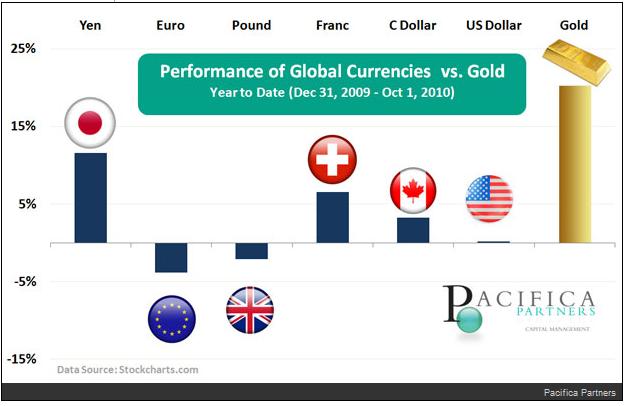
For those of you who haven’t been following this story, a handful of the world’s largest Central Banks are now battling with each to see who can devalue their currency the fastest. [Of course, this war is being couched in euphemistic terms, but make no mistake: it is indeed a form of battle]. The principal participants are emerging market economies, which worry about the impact of rising currencies on their export sectors. However, industrialized countries have also intervened directly (namely Japan) and indirectly (US, UK).
Among the major currencies, there are only a few that continue to sit on the side-lines, including the Euro (to a certain extent), Canadian Dollar, and Australian Dollar. For as long as the currency war continues, these currencies and the handful of emerging market currencies that have forsworn intervention will be the winners (at least from the point of view of speculators that deliberately bet on them).
Then there are those that believe all currencies will suffer, and that even the currencies that are still rising are actually depreciating in real terms (due to inflation). Those who harbor such beliefs will often try to short the entire currency market, usually by betting on commodities or heavy metals, of which Gold is probably the most prominent.
The price of Gold has risen more than 20% this year (in USD terms). Its backers claim that it is the ultimate store of value (where this derives from is unclear), and defend its lack of utility and inability to accrue interest by arguing that its appreciation is more than enough of a reason to own it. When you look at the performance of gold over the last five years, you begin to wonder if maybe they have a point.
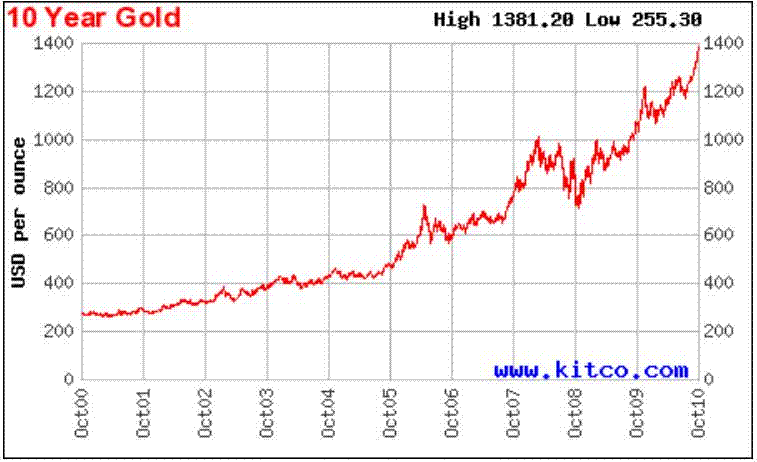
Interest in Gold as an investment has surged in the last couple years (and especially the last few months), as the currency wars have heated up and the Federal Reserve Bank contemplates an expansion of its Quantitative Easing program (dubbed” QE2″). On the one hand, the notion that the only way to defend against real currency devaluation is to own “alternative” currencies is well-founded. On the other hand, regardless of the fact that the Fed has already minted $2 Trillion in cash and that the US national debt is expanding by $1 Trillion per year, inflation in the US is low. In fact, it’s at a 50-year low, and at an annualized .9%, it’s practically non-existent. You would think that with Gold’s unending appreciation, we would be in the midst of hyperinflation, but that’s simply not the case.
In the short-term, then, there’s really not a strong fundamental basis for investing in gold. That’s not to say that it won’t continue to appreciate and that investors will continue to buy into it merely to benefit from what has become self-fulfilling appreciation. From where I’m sitting, though, there’s really no foundation for this appreciation. Consider, for example, that gold investors still have to convert their gold back into paper currency in order for it to to be “used;” otherwise, it offers no benefit to the owner except that it looks pretty (though most investors wouldn’t know, since they buy gold indirectly). Not to mention that if/when the Dollar stops depreciating, there really isn’t really a justification to buy gold as a short-term store of value.
Over the long-term, the picture is certainly more nuanced. I’m not going to explore the viability of fiat currencies here, but suffice it to say that, “Positioning for significantly higher gold prices over the long run demands a very bold strategic bet: that the global monetary system as we know it will completely break down and be replaced with a gold standard.” Regardless of the merits of this point of view, those that invest in Gold should at least understand that this is really the only justifiable reason to hold it. Those who are buying it because of the ongoing currency war will be disappointed.
Gold Rises as “Alternative Currency”
Everything in forex is relative, right? Actually, it turns out this adage is wrong, as there is now a way you can short the entire forex market! I’m not talking about some innovative new financial product that you’ve never heard of, but rather something that everyone already knows about: Gold.
Before you accuse me of sounding like an infomercial, consider that while gold has been an investable commodity for quite some time, its trading pattern has changed recently, especially in the context of forex. Before, the link between gold and forex was inverse and clear: “When the greenback strengthens…this tends to pressure gold since it reduces the need to buy as a hedge against a soft dollar. Also, a strengthening dollar makes commodities generally more expensive in other currencies.” In other words, a rising Dollar is usually accompanied by falling gold prices, and vice versa.
Over the course of 2010, this relationship has steadily grown weaker and weaker, and in the last month, it has almost completely broken down. To understand the rationale for such a change, one needs not to look any further than the sovereign debt crisis currently facing Greece and indirectly, the Eurozone. This crisis has affected the way that investors think about gold; while previously it was primarily viewed as an inflation hedge, now it is seen as a hedge against fiscal/financial crisis. In this regard, it has assumed the characteristics of a “safe haven” currency, much like the US Dollar.
“Gold is going to move higher regardless of what happens in the currency market, as long as there are fears of problems in Europe. People are starting to have more skepticism to a lot of these sovereign entities,” explained one analyst. At the moment, that means that the inverse correlation between the Dollar and Gold (Dollar Up = Gold Down) appears to have reversed itself, such that a rising Dollar is also accompanied by rising gold. In this case, there may be correlation (since investors are buying both gold AND the Dollar as safe haven vehicles) but there is no causation between the two as there was before.
At the moment, the correct interpretation is that anything is preferable to the Euro (whose sovereign debt problems are the most pressing). Thus, gold prices are rising at basically the same rate as the Euro as falling, and gold prices in local currency (EUR, CHF, GBP) terms are already at record levels.
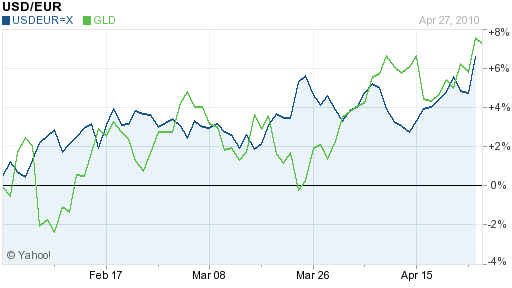
As for the future, however, many are betting that gold will distance itself from the Dollar as well, if/when the fiscal “problems” of the US escalate to the level of a Greek-style crisis. At this point, Gold will start to trade as an alternative to the entire forex market! In fact, gold contracts denominated in US Dollars have also been rising, which means that investors already perceive it as more than just an alternative to the Euro. (If this was the case, one would expect gold to appreciate in terms of Euros, but to remain constant or even fall when priced in Dollars. This clearly hasn’t happened).
Admittedly, gold is outside of my expertise, so I’ll refrain from personally making any predictions. According to Deutsche Bank, “If the correlation re-establishes itself before July, either the dollar must continue to decline or investment into bullion-backed funds must pick up in order to avoid erosion in gold prices.”
Regardless of what happens, my intention here is simply to point out the emergence of this trend, for its own sake. While it doesn’t have any serious implications about the internal dynamics of forex markets, it most certainly is important insofar as it reflects what investors (forex and otherwise) are generally thinking about. In this case, it signals that concern over the ongoing sovereign debt crisis isn’t going to abate anytime soon.
Before you accuse me of sounding like an infomercial, consider that while gold has been an investable commodity for quite some time, its trading pattern has changed recently, especially in the context of forex. Before, the link between gold and forex was inverse and clear: “When the greenback strengthens…this tends to pressure gold since it reduces the need to buy as a hedge against a soft dollar. Also, a strengthening dollar makes commodities generally more expensive in other currencies.” In other words, a rising Dollar is usually accompanied by falling gold prices, and vice versa.
Over the course of 2010, this relationship has steadily grown weaker and weaker, and in the last month, it has almost completely broken down. To understand the rationale for such a change, one needs not to look any further than the sovereign debt crisis currently facing Greece and indirectly, the Eurozone. This crisis has affected the way that investors think about gold; while previously it was primarily viewed as an inflation hedge, now it is seen as a hedge against fiscal/financial crisis. In this regard, it has assumed the characteristics of a “safe haven” currency, much like the US Dollar.
“Gold is going to move higher regardless of what happens in the currency market, as long as there are fears of problems in Europe. People are starting to have more skepticism to a lot of these sovereign entities,” explained one analyst. At the moment, that means that the inverse correlation between the Dollar and Gold (Dollar Up = Gold Down) appears to have reversed itself, such that a rising Dollar is also accompanied by rising gold. In this case, there may be correlation (since investors are buying both gold AND the Dollar as safe haven vehicles) but there is no causation between the two as there was before.
At the moment, the correct interpretation is that anything is preferable to the Euro (whose sovereign debt problems are the most pressing). Thus, gold prices are rising at basically the same rate as the Euro as falling, and gold prices in local currency (EUR, CHF, GBP) terms are already at record levels.

As for the future, however, many are betting that gold will distance itself from the Dollar as well, if/when the fiscal “problems” of the US escalate to the level of a Greek-style crisis. At this point, Gold will start to trade as an alternative to the entire forex market! In fact, gold contracts denominated in US Dollars have also been rising, which means that investors already perceive it as more than just an alternative to the Euro. (If this was the case, one would expect gold to appreciate in terms of Euros, but to remain constant or even fall when priced in Dollars. This clearly hasn’t happened).
Admittedly, gold is outside of my expertise, so I’ll refrain from personally making any predictions. According to Deutsche Bank, “If the correlation re-establishes itself before July, either the dollar must continue to decline or investment into bullion-backed funds must pick up in order to avoid erosion in gold prices.”
Regardless of what happens, my intention here is simply to point out the emergence of this trend, for its own sake. While it doesn’t have any serious implications about the internal dynamics of forex markets, it most certainly is important insofar as it reflects what investors (forex and otherwise) are generally thinking about. In this case, it signals that concern over the ongoing sovereign debt crisis isn’t going to abate anytime soon.
Gold and the Euro? I thought it was Gold and the Dollar?!
Let me preface this post, by noting that I try to avoid writing about gold, since there are some many other excellent analysts out there writing about the subject. But when there is a such a strong overlap between gold and forex markets, well, I just can’t resist!
Recently, gold prices have collapsed at virtually the same rate as the Euro, with the result being a near-record high short-term correlation between EUR/USD and gold prices. This has caused no shortage of confusion among gold-watchers, which are accustomed to seeing the strongest (inverse) correlation with the US Dollar. This change is causing everyone to rethink some classically held assumptions about gold prices.
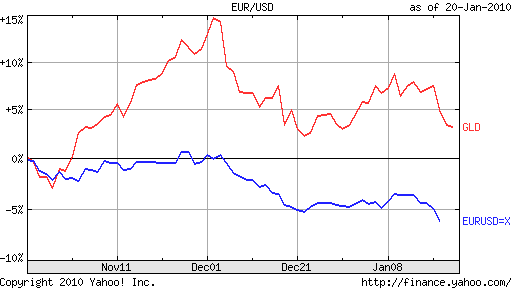
The foremost of which is that gold is chiefly a hedge against the Dollar, which is a symbol for inflation and erosion of value. [In fact, analysts argue that gold has little real purpose (besides a handful of trivial practical uses, such as jewelry), especially since holders of gold don't receive interest, there is little reason to own it other than as a store of value]. Thus, as the Dollar has declined over the last five years, gold has soared. Investors who are nervous about perennial budget deficits in the US and the skyrocketing national debt, have turned to Gold because of the belief it will continue to hold its value even (or especially) if the US government is forced to devalue its debt by devaluing the Dollar. While this tenet underlies the gold/Dollar inverse relationship, the long and short of it is that investors typically buy gold when the Dollar falls, and vice versa. Thus, when the credit crisis struck and the Dollar rallied, gold prices fell, despite the fact that the US was now more likely to default on its debt.
In the last month, however, the Euro has taken center stage in dictating the price of gold. This is most likely because of the sovereign debt problems of certain EU countries. A not insignificant number of which well exceed the budget (not to exceed 3% of GDP per year) and debt (not to exceed 60% of GDP) limitations imposed on them by their membership in the EU. Recent credit rating downgrades have underscored an increasing likelihood of default, which has been duly noted both by the forex and gold markets. As the Euro has dropped (quite dramatically in fact), so has gold.
According to the current paradigm, this is not wholly unsurprising, since the Euro’s fall has naturally been mirrored by a rise in the Dollar. Thus, if you continue to look at gold prices in terms of the Dollar, it seems naturally that a rising Dollar is being accompanied by falling gold. On the other hand, the fact that the Dollar is suddenly rising has little to do with a change in US fundamentals, and instead reflects the fact that in forex, it’s impossible to short all currencies simultaneously, even if sometimes fundamentals would justify such an approach.
In other words, that certain EU member states are more likely to default on their respective debt obligations has limited bearing on whether the US will also default. [If anything, it increases the likelihood, since a default in the EU would likely send sovereign borrowing costs higher around the world, straining the ability of the US to continue borrowing]. By extension, the current drop in the price of gold is fundamentally irrational, especially when viewed relative to currency markets. To borrow a hackneyed expression, perhaps it’s time for a paradigm shift.
Swiss Franc at Record Highs
This month, the Swiss Franc touched a record high against not one, but two currencies: the US dollar and the Euro. Having risen by more than 30% against the former and 20% against the latter, the franc might just be the world’s best performing currency over the last twelve months. Let’s look at the prospects for continued appreciation.
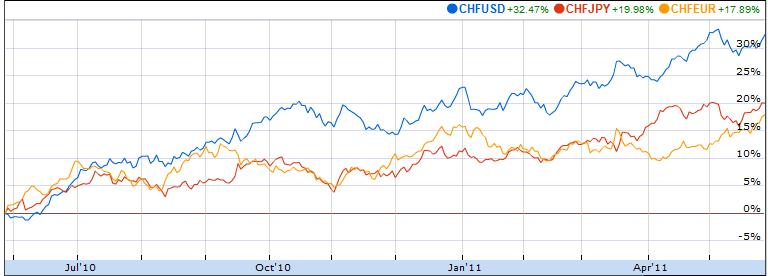
As I wrote on Monday, the Swiss Franc has been one of the primary beneficiaries of the safe haven trade. With each spike in volatility, the Swiss Franc has ticked upward. Due to monetary and fiscal stability as well as political conservatism, investors have flocked to the Franc in times of crisis. Of course, the Japanese Yen (and the US dollar, of late) has also received a boost from this phenomenon, but to a lesser extent than the franc, as you can see from the chart above.
Personally, I wonder if this isn’t because the Swiss economy is significantly smaller than that of Japan and the US. In other words, its capacity to absorb risk-averse capital inflows is much smaller than that of Japan and the US. For example, the impact of one million people suddenly rushing out to buy shares in IBM stock would have a much smaller impact on its share price compared to a sudden speculative flood into FXCM. The same can be said about the franc, relative to the dollar and yen.
Ironically, the franc is also rising because of regional proximity to the eurozone. I use the term ironic to denote in order to signify that the franc is not being buoyed by positive association with the euro but rather because of contradistinction. In other words, each time there is another flareup in the eurozone sovereign debt crisis, the franc typically experiences the biggest bounce because it is the easiest currency to compare with the euro. In some ways, it is basically just a more secure version of the euro. This phenomenon has intensified over the last month, as the euro faces perhaps its most uncertain test yet.
It is curious that even as investors have gradually become more inclined to take risk, that not only has the franc held its value, but it has actually surged! Perhaps this is because it is expected that the Swiss National Bank (SNB) will soon hike interest rates, making the franc both high-yielding and secure. To be sure, some analysts think that the SNB will hike as soon as June. The fact the the economy has continued to expand and exports have surged in spite of the strong franc only seems to support this notion.
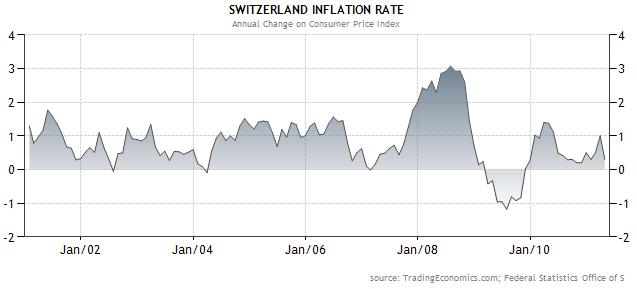
On the other hand, inflation is still basically nil. And just because the Swiss economy can withstand an interest rate hike hardly provides adequate justification for implementing one. Besides, the SNB hardly wants to give the markets further cause to buy the franc. If anything, it may even need to intervene verbally to make sure that it doesn’t rise any higher. Thus, “The median forecast among economists is for a rate increase in September.”
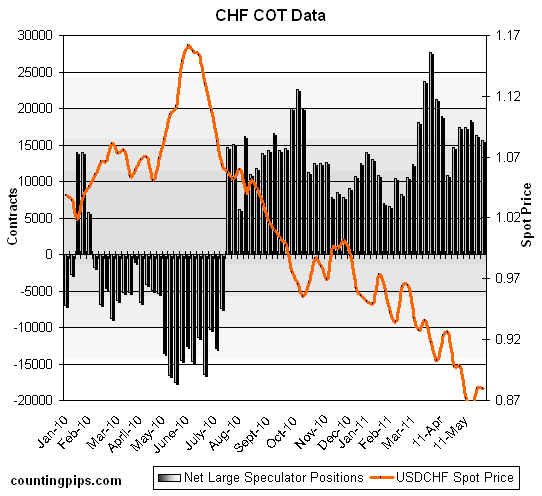
In short, I think the franc is overbought against the dollar. In fact, you can see from the most recent Commitment of Traders data that speculators have been net long the franc for almost an entire year, and it seems inevitable that this will need to reverse itself. On the other hand, the franc probably has more room to rise against the euro. The takeaway here is that it is less important to know where you stand on the franc in general and more important to understand the cross currency.
High-Frequency Traders Descend onto Forex Markets
High-Frequency Traders Descend onto Forex Markets
According to a recent report by the Wall Street Journal, high-speed traders are quickly establishing themselves as the main force in forex markets. Just like in other financial markets, a significant portion of trading volume is dominated by computerized trading, in which huge blocks of currency can change hands multiple times in mere milliseconds. While this is certainly old news for hedge funds and other institutional traders, it may come as a slight surprise to retail traders, many of whom still see forex as the neglected stepsister of stocks, bonds, and other assets. Nonetheless, there are a number of implications for the forex markets, and retail traders would be wise to heed them.
Here are the facts: “High-frequency trading accounted for roughly 30% of all foreign-exchange flows, as of 2010, compared with 13% in 2004, according to Boston-based consulting firm Aite Group. (By contrast, 66% of global stocks trading is high frequency.” According to Aite Group, it will jump to 42% by the end 2011 and to 60% in 2012. “About 85% of the currency market’s growth in volume from 2007 to 2010 came from financial institutions like hedge funds [represented as other financial institutions in the chart below] rather than Wall Street’s traditional bank currency dealers, thanks partly to high-frequency traders.”
According to the Wall Street Journal, this is changing the way in which currencies are traded. Previously, for big blocks of currency, traders would have to manually request a quote from Wall Street brokerages, which still dominate forex trading through the interbank market. The brokerage would match up buyer and seller (or step in and fulfill one of the roles itself) and take a cut, in the form of the spread. Retail traders, on the other hand, have never known such a troublesome process, having always been afforded electronic quotes and instant execution. However, the price paid for this convenience comes in the form of wide spreads, since both your retail broker and its representative on the interbank markets must both earn a profit.
In fact, wide spreads recently came under attack by Karl Deninger and sparked a fierce debate about whether it is still possible for retail traders to turn a profit using high-frequency (albeit non-computerized) trading methods. Fortunately, the Wall Street Journal is reporting that spreads have already fallen to one pip (though it didn’t specify the currency pair) thanks to new systems that have been set up to cater to high-frequency traders. It seems only a matter of time before these systems are either adapted to the retail market and/or replace the interbank market as the market-maker for retail brokerages. (Given that a handful of banks are currently under investigation by the SEC for deceptive quoting practices, a changing of the guard probably isn’t such a bad thing!)
In addition, while high-frequency trading has increased liquidity and lowered spreads, it has probably increased volatility. Sudden spikes quickly becomes exacerbated as automatic stop orders flood the market. You can see from the chart below the abundance of such spikes, the most recent one on March 11 caused by the Japanese natural disasters. Overall volatility is also at elevated levels, though it’s impossible to know how much of this is due to an increase in high-frequency trading and how much is simply due to post-financial crisis uncertainty. In any event, retail traders with ultra-short time horizons have no choice but to play the same game, by maintaining active stop-loss orders. Traders should also consider reducing leverage, since sudden spikes can trigger margin calls and wipe out entire accounts. (For the record, of the dozens of interviews I have conducted over the last couple years, I have yet to find one expert that condones the use of leverage greater than 5:1.In my opinion, leverage is still nothing more than a cynical marketing tool), but I digress…)

Ultimately, I think this is just further evidence that day-trading forex is only going to become more difficult. According to a research paper (that I spotlighted in an earlier post), algorithmic trading has already caused a decline in the power of technical analysis. Presumably, this is because computerized trading systems are better than humans at identifying trends and faster at executing trades designed to profit from them. In the end, outsmarting computers is unlikely, since both human traders and their electronic counterparts use the same forms of deductive reasons to spot potential trading opportunities. At the same time, the algorithms are still “stupid.” They are designed by humans and can only consider the variables that have been inputted them, which are inherently technical in nature. To beat them, you merely have to beat their human designers. In practice, this probably means designing more creative strategies based on more complex analytical tools and/or considering fundamental factors in addition to technical ones.
الاشتراك في:
الرسائل (Atom)